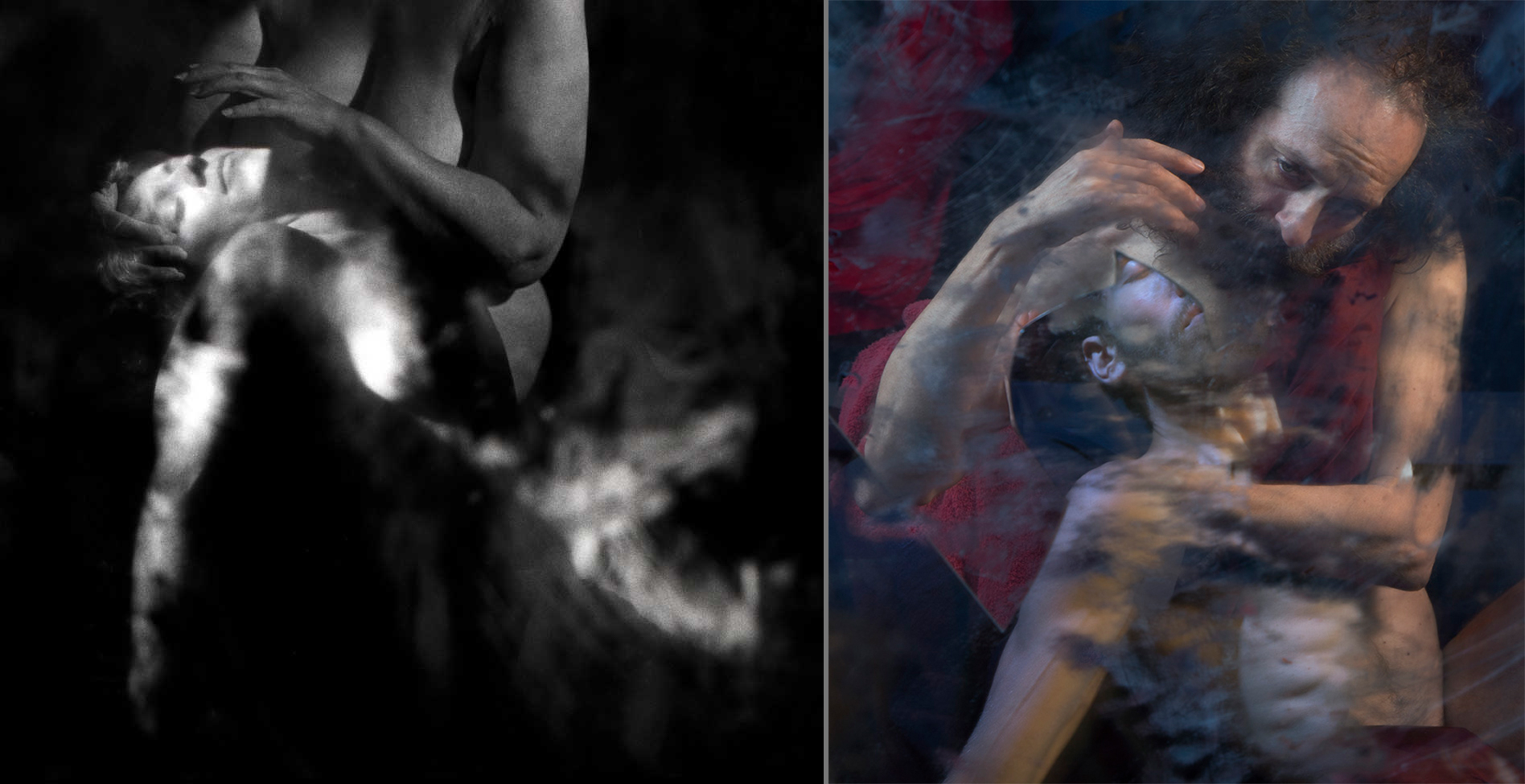Work samples
-
Untitled (#4442) 1992
"There is no excellent beauty that hath not some strangeness in the proportion." Francis Bacon
Working in the mirrors was very exciting, but also physically and mentally draining. Many of the images were psychologically heavy, and visually quite difficult to create, and so I returned to the water, this time working with a hot tub and underwater strobes. I found myself drawn to simplifying the human form, finding elegant lines, graceful movement, strange yet beautiful and distinctly human shapes. It also offered an opportunity to do something I tell students all the time- to simplify. The light from under the water would isolate the submerged forms, and the distorting effect would often give the body a fluid, ethereal feeling.
-
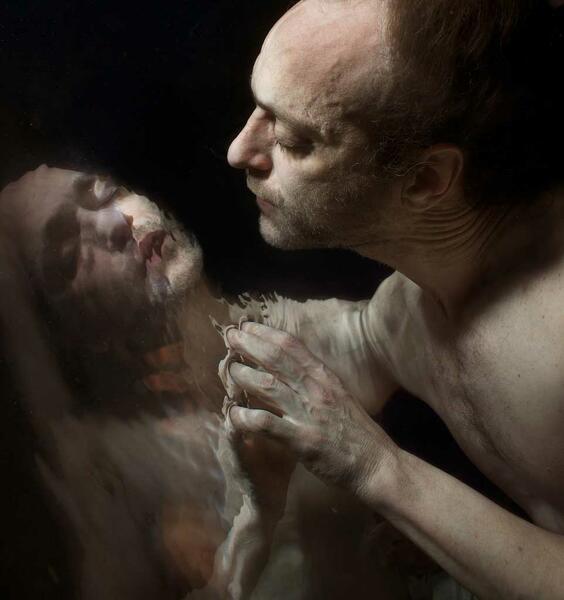 Untitled (# 04-14-09-462) 2014
Untitled (# 04-14-09-462) 2014"I weep for Narcissus, but I never noticed that Narcissus was beautiful. I weep because, each time he knelt beside my banks, I could see, in the depths of his eyes, my own beauty reflected.” ― Paulo Coelho, The Alchemist
This image, made in 2009, is just one model and his reflection. The model and I are both underwater, and he is looking up. The figure on the right is aware, conscious and giving all his attention to the figure on the left – his reflection. Though there is in fact only one model, this image shows two entirely different points of view: one as a profile, the other as a full face, resulting in the appearance of two people with distinct emotions. It is no surprise that as I initially studied this image the figure of Narcissus came to mind.
About Connie
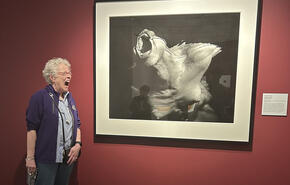
Being a board member of the William G. Baker Jr. Memorial Fund, I am not elegible for prize money, however, I have enjoyed tremendously the process of putting my portfolio together and experiencing the website for myself.
I am screaming at one of my photographs on view in an exhibition at the National Museum of Women in the Arts, "Uncanny" in 2025.
My fascination with photographing the nude reflected in water started in the mid 1980's when a VERY good friend … more
A brief introduction to 50 years of my photographs
Over 50 years of photographing the same subject may sound limiting, but I have found the process to be immensely rewarding and rich. While my interest in photographing the nude reflected in mirrors and water has not changed, my life experiences continue to shape the forms and reflections I see through the lens so the images continue to evolve.
I have been working on two approaches to the nude reflected: reflected in water often with the camera underwater, and reflected in scratched, broken and partially de-silvered mirrors.
Though technology and the materials have fluctuated throughout the years, all of my work is seen through the camera, discovered through years of looking at reflections. I am not fundamentally opposed to altering the image through darkroom or computer manipulation, but it is the act of exploring with my eyes that brings the intuitive process to its full potential for me. My goal has always been to explore the body, not to alter it. It leads me to examine the angles, space, reflections, and light from which the forms can be the most interesting they can be – whatever that is. I strive to make the forms make sense visually and then trust the poetry or metaphor will follow. Sometimes it does.
Intuition is an integral part of the creative process for me. When I make an image that becomes a “keeper,” it is because I have made a leap from what I know to an unfamiliar place full of intrigue that my conscious mind could not have taken me. Through this process, I have made exciting visual discoveries, and remarkable unintended references and visual connections in my images to other works of art throughout history. It has lead me on a journey of self discovery, often looking at parts of myself and my psyche that – although not always comfortable- has enlightened the experience of my life. This intuitive process takes me to the edge of what I know and, more interestingly, to the edge of what I don’t know.
-
Sainthood 1987
-
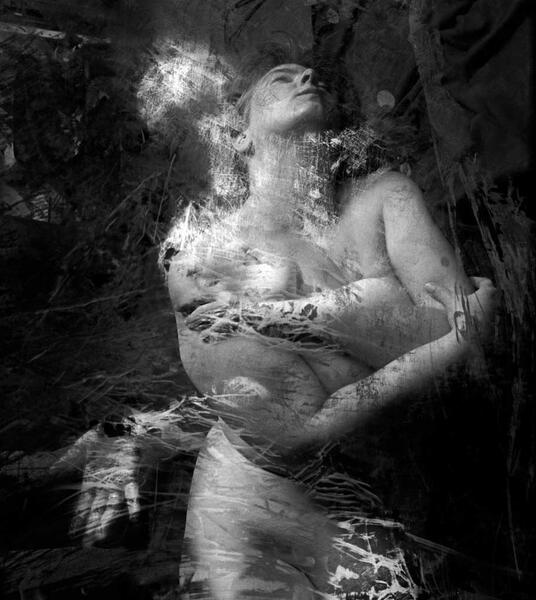 Untitled (#3572) 1989
Untitled (#3572) 1989 -
Untitled (#4442) 1992(Untitled (#4442) 1992) "There is no excellent beauty that hath not some strangeness in the proportion." Francis Bacon
-
Untitled (#5978,) 1994
This has been one of my favorite images from this era. I love the rawness of it, how primal it feels. I've written extensively on the unintentional connection it bears with the work of one of my artist idols, Francis Bacon.
-
Untitled (#09-04-13-287) 2013
-
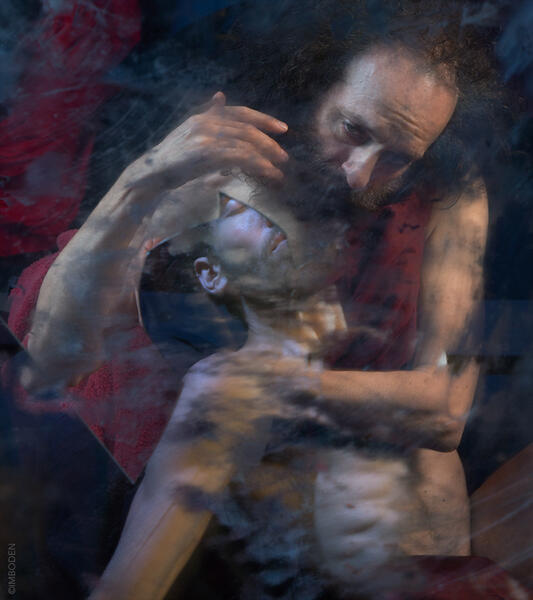 Untitled (#06-05-15-258) 2015
Untitled (#06-05-15-258) 2015 -
Untitled (#07-05-19-401) 2019
Two models, broken mirrors and red light
-
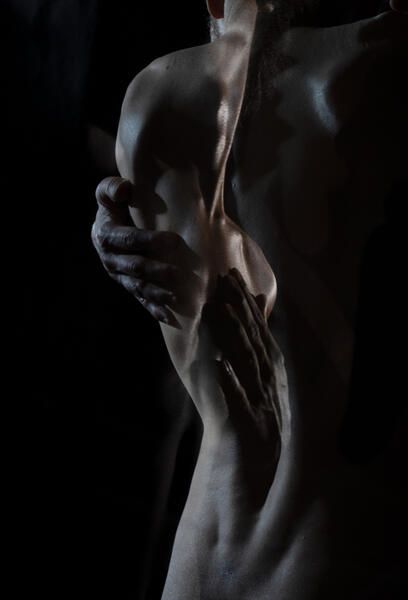 Untitled (#12-29-2023-225) 2023
Untitled (#12-29-2023-225) 2023 -
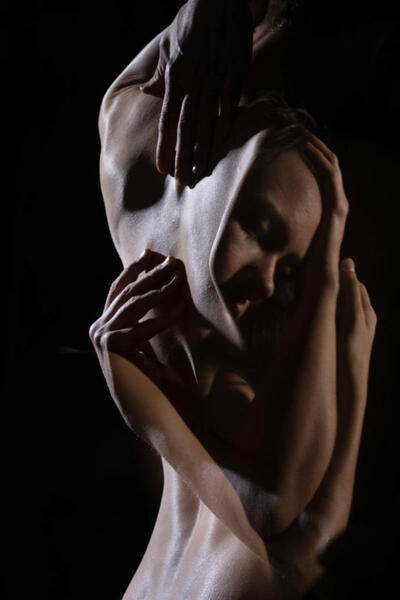 Untitled (#01-17-2023-298) 2023
Untitled (#01-17-2023-298) 2023While it's true for all of my work, every so often an image comes along that reminds me that I could never think of or preconceive these photos. This feels so complex, so intricately illusory, so magnificently bizarre yet makes some sort of visual expressive sense. The way the face fits so perfectly into the shoulder blade, the wrapping embrace of the arms, the evocative expression despite the ambiguity of "what exactly is happening here?". It has taken the entire course of my work - 30+ years - to arrive at the intricate technical aspects that have all had to come together to create something like this, details of which I still am confounded and delighted by. Like an alchemical process, working for years with the same basic materials, transforming the same subject matter into something potent and, to me, something precious.
-
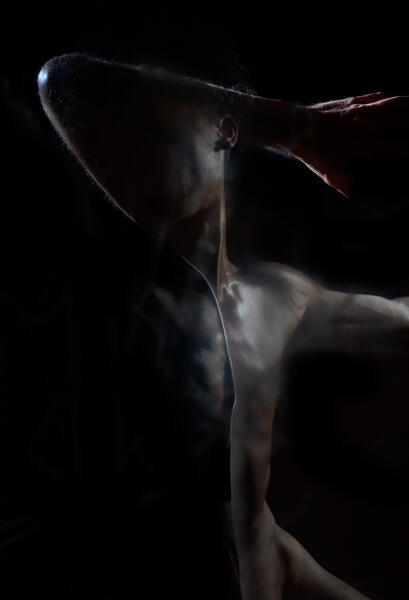 Untitled (#08-15-2025-72) 2025
Untitled (#08-15-2025-72) 2025One thing I continue to marvel at in some of these more recent images is the fluidity and grace of some of the forms that echoes work from the water. I don't always understand where it is going or what it all means, but I recognize in this work the same sort of ethereal quality that came through in many of the images photographed in, above, and below the water's surface.
The Power of Connections
The view from 50 years –
It boggles my mind to think that I have been doing photography for more than 50 years (actually 53!) For almost 40 of those, I have photographed the human form exclusively (reflected and distorted in water and mirrors.) In addition to recognizing that I am no longer considered middle-aged, this realization offers me a unique and valuable perspective.
Seeing 50 + years of work in a retrospective last year showed me very defined threads that run throughout my imagery. It also revealed something else. It showed me that my work includes recurring themes and expressions that I revisit at different times, often separated by years or even decades. This is the result of following an intuitive process leading to unconscious material, both personal and collective. Both are powerful and offer invaluable insights and connections.
According to C.G. Jung, the Collective Unconscious is present and established within every individual from birth. It is the shared humanity that connects us. The potential that creative, intuitive process and product can offer is a deep and powerful connection – to ourselves, and to each other. Recognizing this connection allows us to acknowledge our shared humanity.
-
 Untitled (#3454) 1990 and Untitled (#06-05-15-258) 2025
Untitled (#3454) 1990 and Untitled (#06-05-15-258) 2025 -
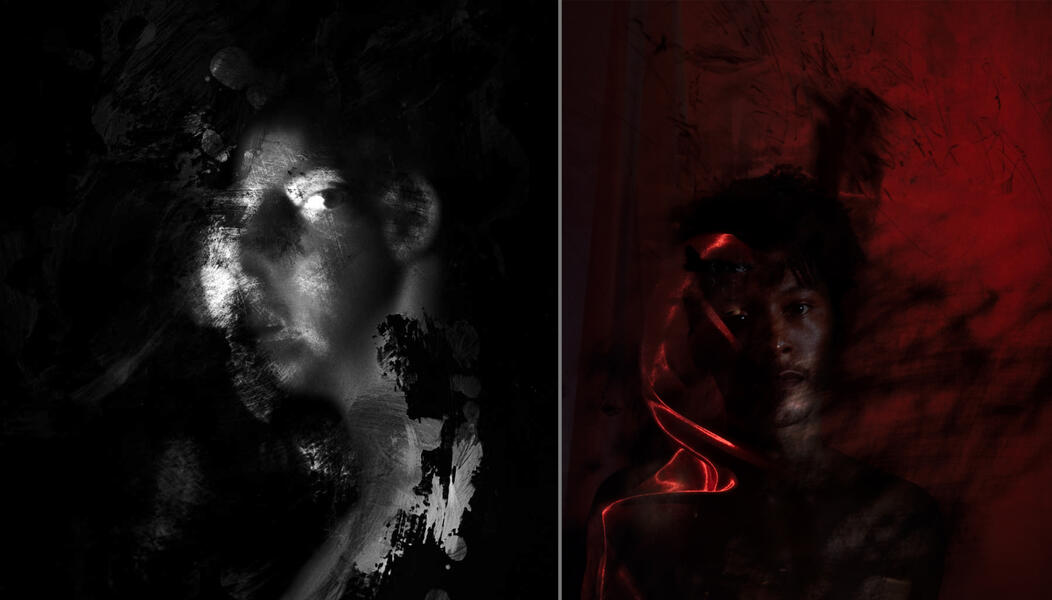 Untitled (#3191) 1990 and Untitled (05-06-2025-29) 2025
Untitled (#3191) 1990 and Untitled (05-06-2025-29) 2025 -
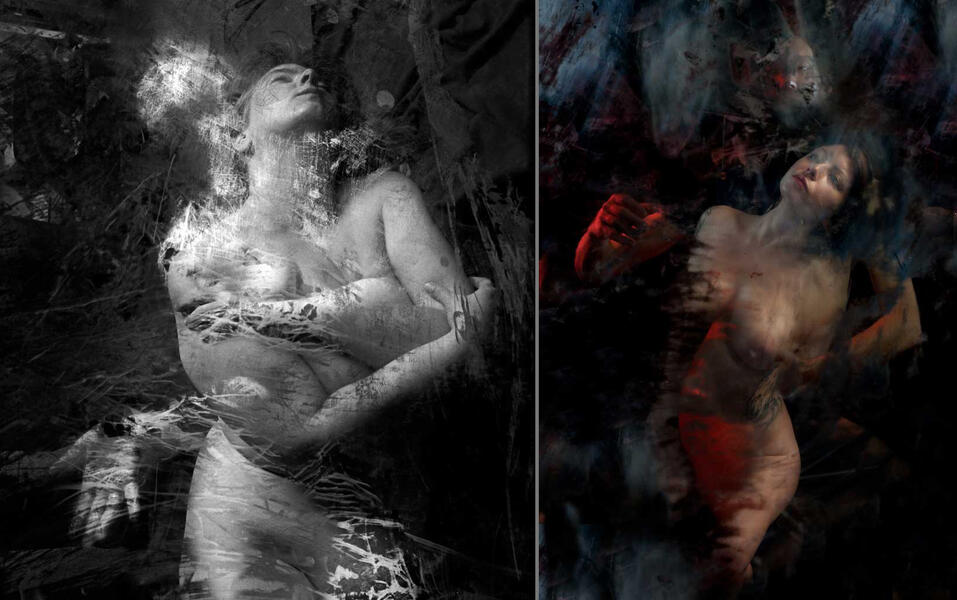 Untitled (#3572) 1990 and Untitled (#9-27-11-0057) 2011
Untitled (#3572) 1990 and Untitled (#9-27-11-0057) 2011 -
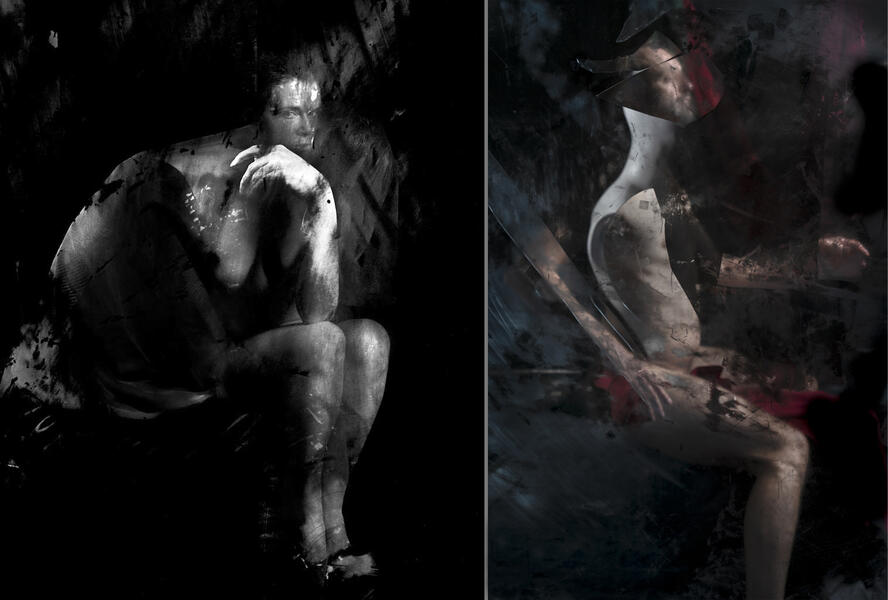 Untitled (#3874) 1991 and Untitled (#06-02-16-436) 2016
Untitled (#3874) 1991 and Untitled (#06-02-16-436) 2016 -
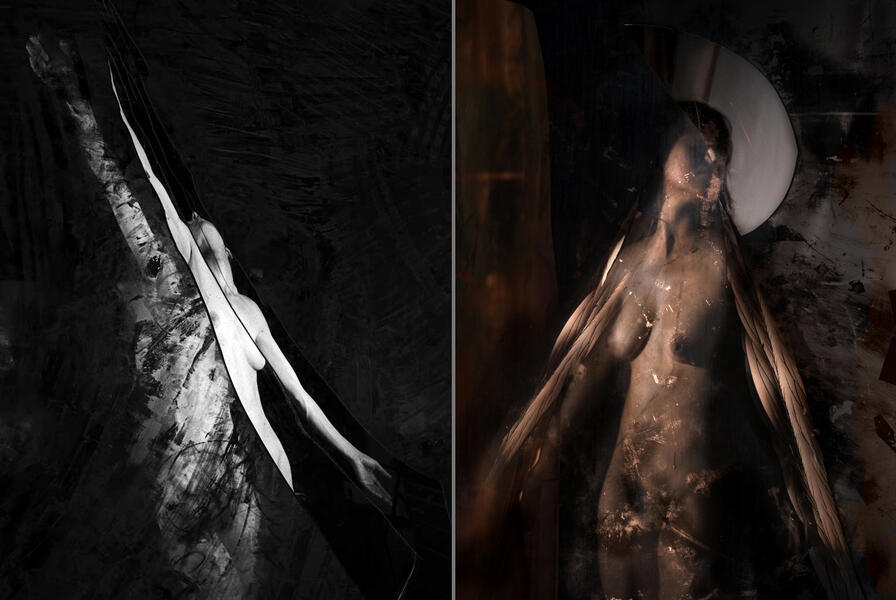 Untitled (#8619) 2000 and Untitled (#06-18-18-642) 2018
Untitled (#8619) 2000 and Untitled (#06-18-18-642) 2018 -
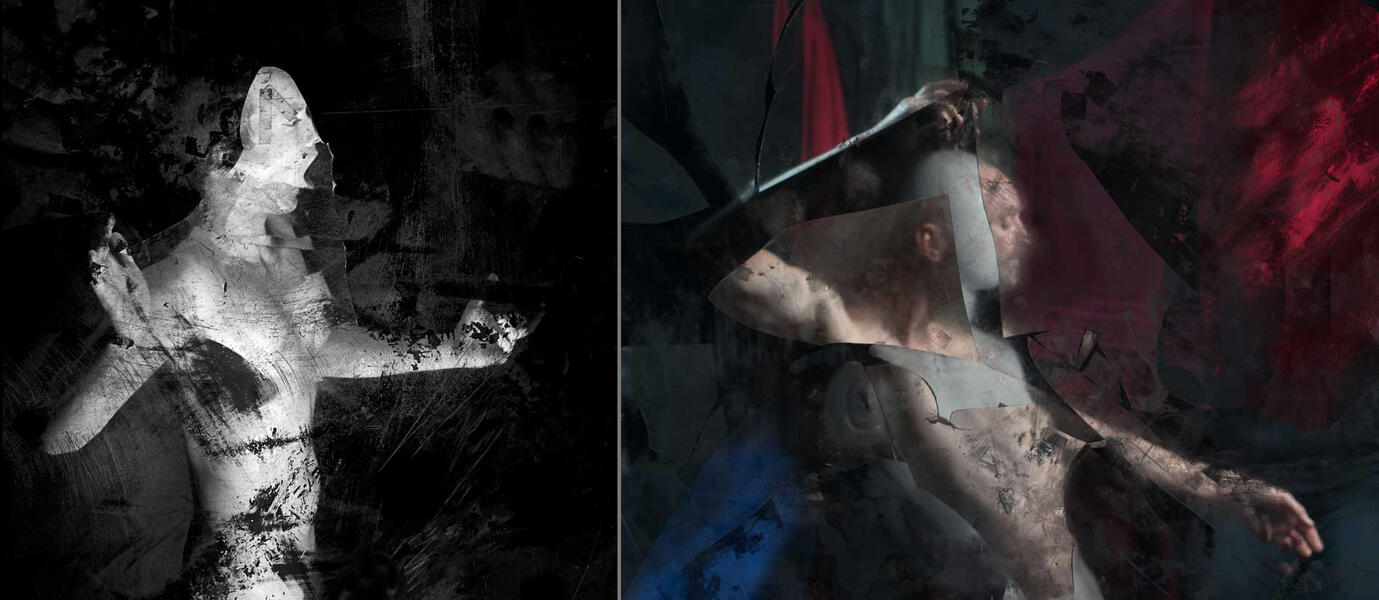 Untitled (#9535) 2002 and Untitled (#06-08-16-429) 2016
Untitled (#9535) 2002 and Untitled (#06-08-16-429) 2016 -
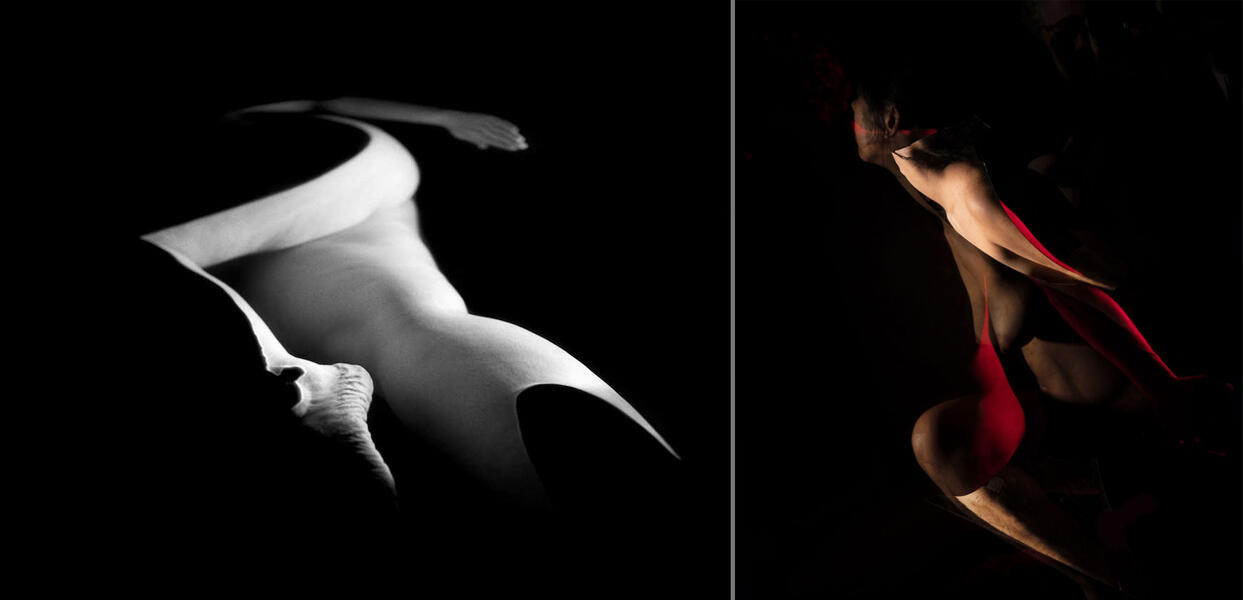 Untitled (#4590) 1992 and Untitled (#07-09-19-685) 2019
Untitled (#4590) 1992 and Untitled (#07-09-19-685) 2019 -
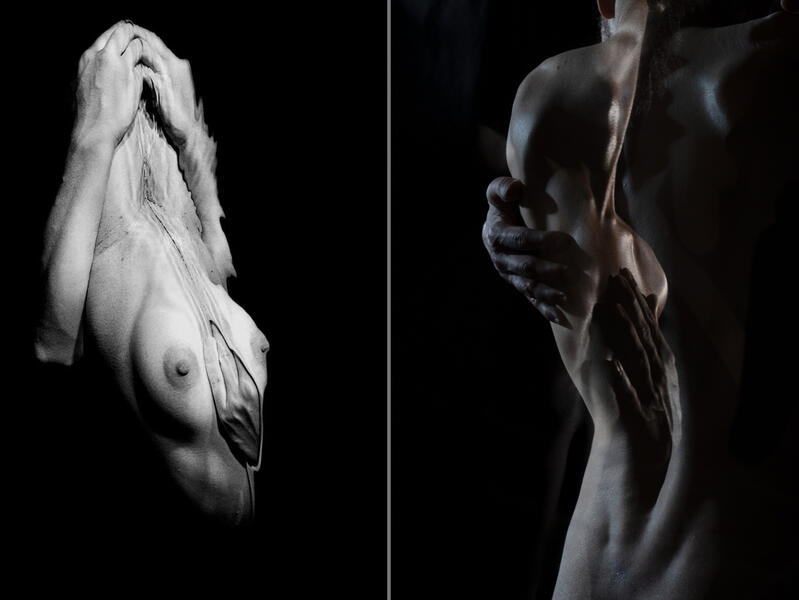 Untitled (#7146) 1997 and Untitled (#12-29-23-225) 2023
Untitled (#7146) 1997 and Untitled (#12-29-23-225) 2023 -
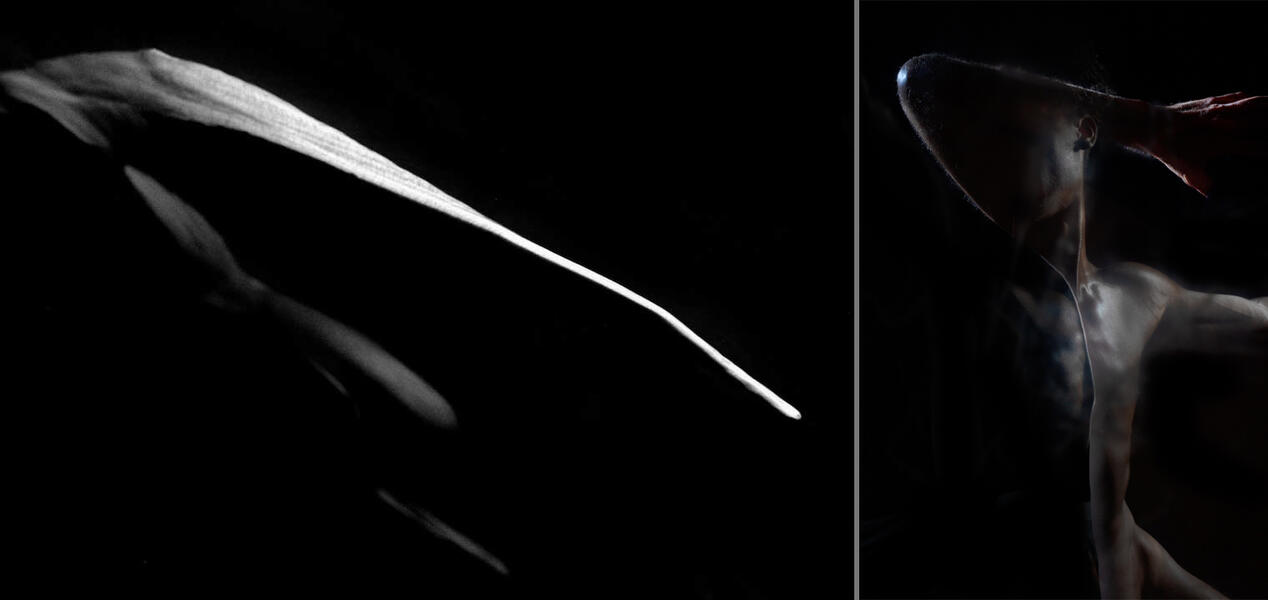 Untitled (#10914) 2004 and Untitled (#08-15-2025-72) 2025
Untitled (#10914) 2004 and Untitled (#08-15-2025-72) 2025 -
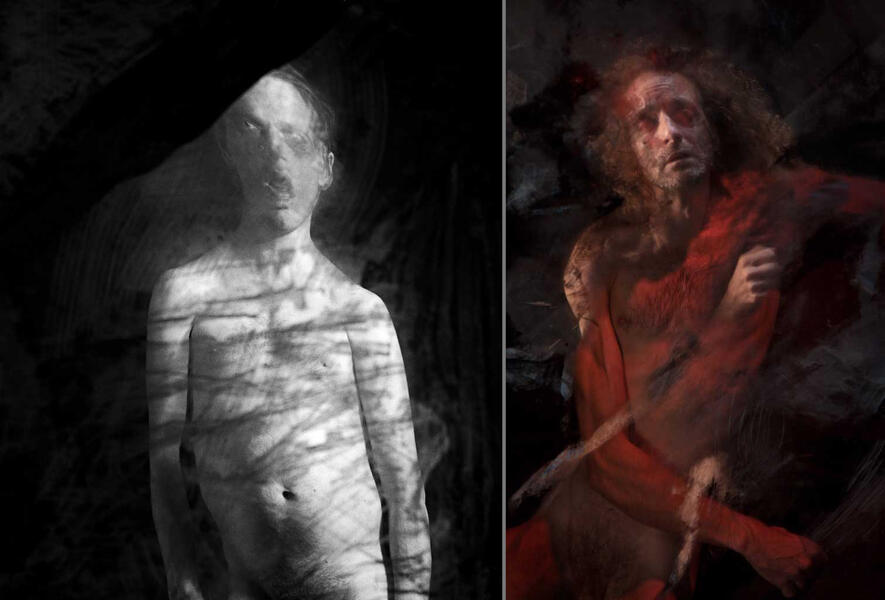 Untitled (#3725) 1991 and Untitled (#Untitled #09-04-13-287) 2013
Untitled (#3725) 1991 and Untitled (#Untitled #09-04-13-287) 2013
More Unintended Connections
I frequently write about, discuss, maybe even obsess, over unintended references and visual connections in my images to other works of art throughout history. My fascination with them started very early on in my career as an artist- as far back as my second year of grad school, when I made an image called "Dead Silences". Fellow students in a critique drew attention to the allusion of Janus, an ancient Roman god often depicted with two faces for his propensity to see both future and past, beginnings and endings, etc. Although I pretended otherwise, I of course had no idea who this deity was at the time, and was fascinated by the accuracy, the uncanniness of my colleagues observation.
This early analogy held such an allure for me - that I could unintentionally create something with such a direct resemblance to an ancient depiction - that I had to know more. I discovered the writings of Joseph Campbell, famous author of the Hero's Journey and Hero with A Thousand Faces, who discussed the various archetypes of characters in stories throughout history. My intrigue led me further down this fascinating rabbit hole, and I found myself captivated by the theories of Carl Jung, the Swiss psychiatrist who put forth the theory that archetypes on a much broader scale - not just the characters of story but patterns, symbols, and information that describe our basic humanity - are actually stored within a deep layer of our mind. Similar to instincts, this layer exists beyond both the conscious and unconscious, in a deeper level of the psyche he called the "collective unconscious”…..
As I look back now, both on the breadth of 50 + years worth of work as well as everything that has happened throughout that expanse of time, I feel the importance of these connections all the more significant. When I'm creating my work, making these images, I'm never thinking about how they relate to one archetype, or motif, or other work of art. It isn't until much later, often times years later or when someone else points them out, before I see these references. BUT, as unaware of them as I or anyone else may be, I am RESPONDING to them. The response to the connection - the way it makes me feel, the expression that saturates my senses, the nearly visceral experience of the work - does not require consciousness of it. That is what makes them so special. They bear resemblances to themes that are universal to all mankind, truths that bind all of us in our humanity, across culture and time.
-
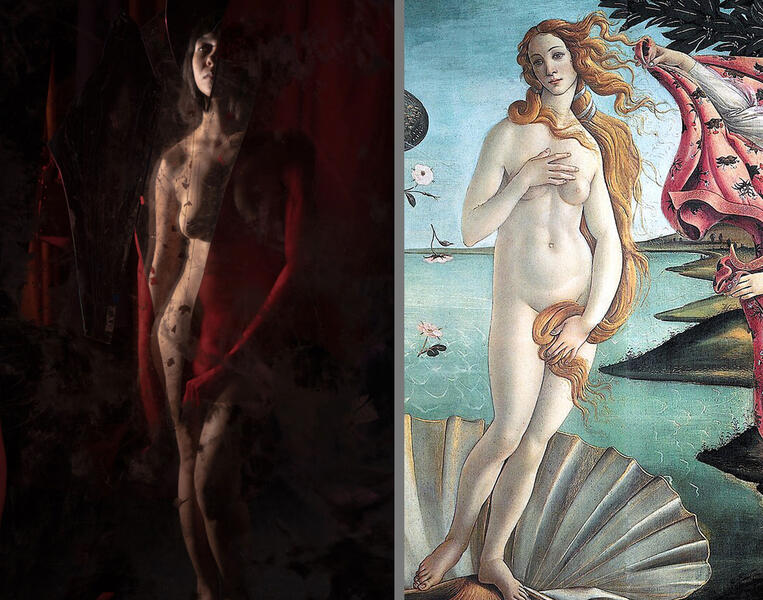 Comparison with Untitled (# 10-19-18-734) and Botticelli's "The Birth of Venus"
Comparison with Untitled (# 10-19-18-734) and Botticelli's "The Birth of Venus" -
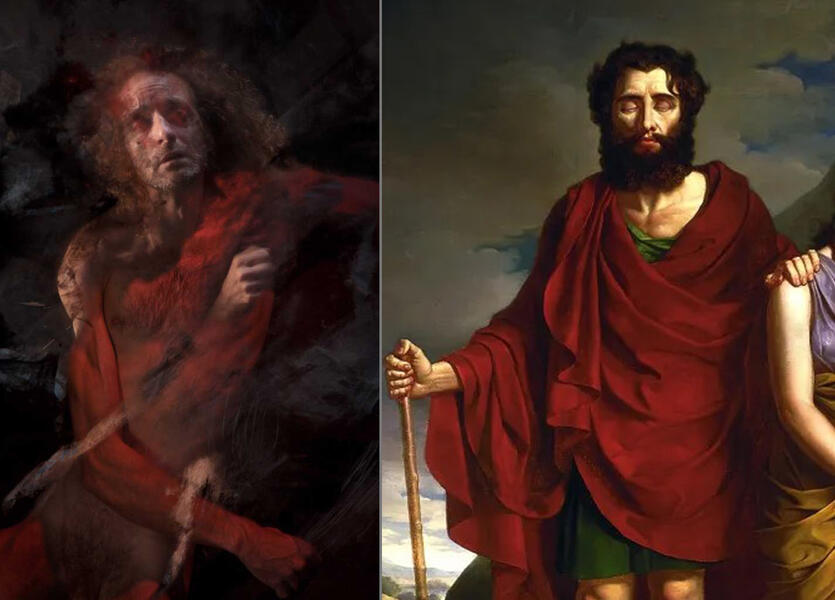 Comparison with Untitled (#09-04-13-287) and Brodowski's "Oedipus and Antigone" 1823
Comparison with Untitled (#09-04-13-287) and Brodowski's "Oedipus and Antigone" 1823Oedipus is the story of a tragic figure who inadvertently marries his mother and kill his father. In his grief he pokes out his eye with rusty nails.
-
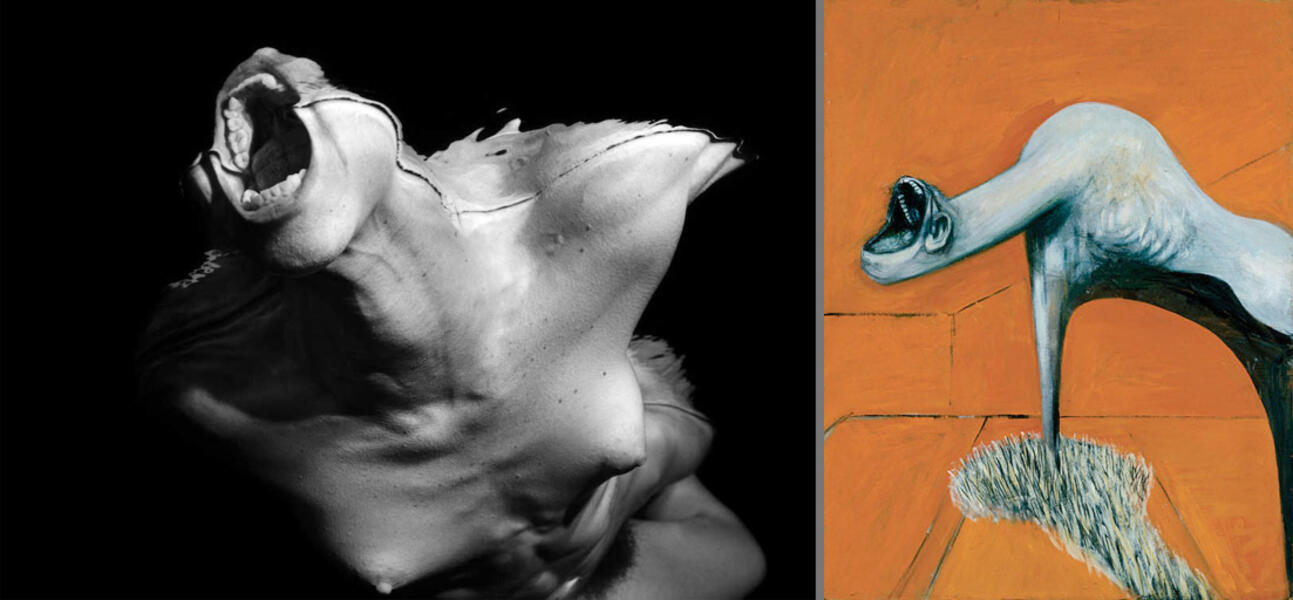 Comparison of Untitled (#5978) with Francis Bacon "Three Studies for Figures at the Base of a Crucifixion" (1944)
Comparison of Untitled (#5978) with Francis Bacon "Three Studies for Figures at the Base of a Crucifixion" (1944)“ Leonardo is present in Cezzane, Michaelangelo flows through Picasso and on to Hockney. This is not ancestor worship, it is the lineage of art. It is not so much influence as it is connection.”
Jeanette Winterson Art Objects
-
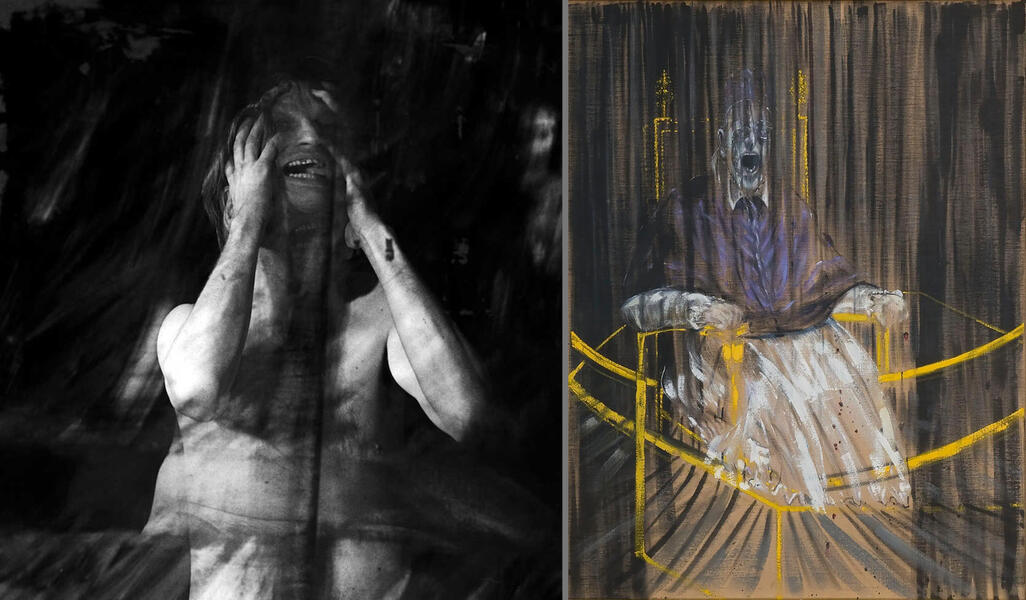 Comparison of Untitled (#3912 )with "Francis Bacon Study after Velazquez Pope Innocent X"
Comparison of Untitled (#3912 )with "Francis Bacon Study after Velazquez Pope Innocent X" -
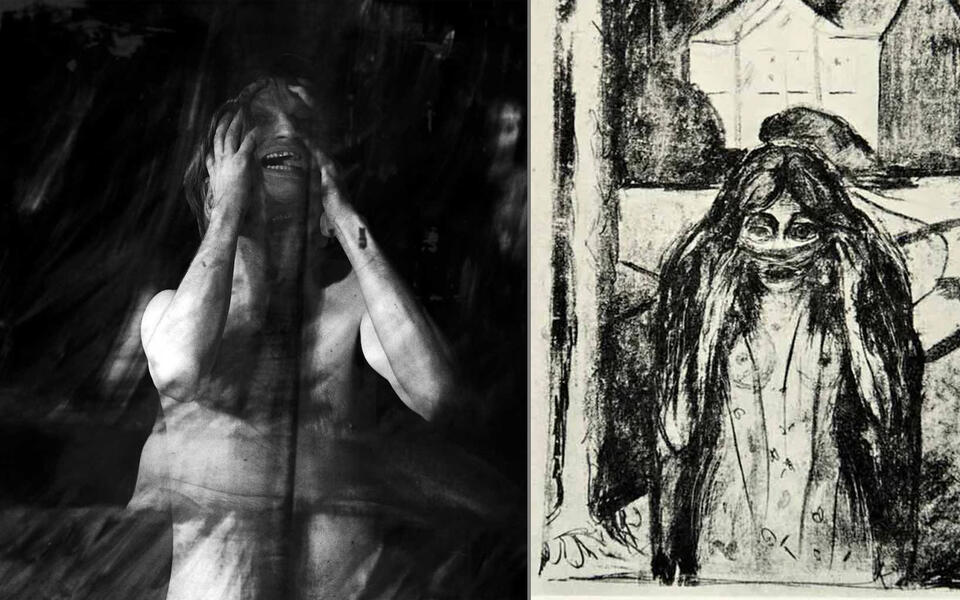 Comparison of Untitled (#3912) with Munch 1958 "Flight Figure"
Comparison of Untitled (#3912) with Munch 1958 "Flight Figure" -
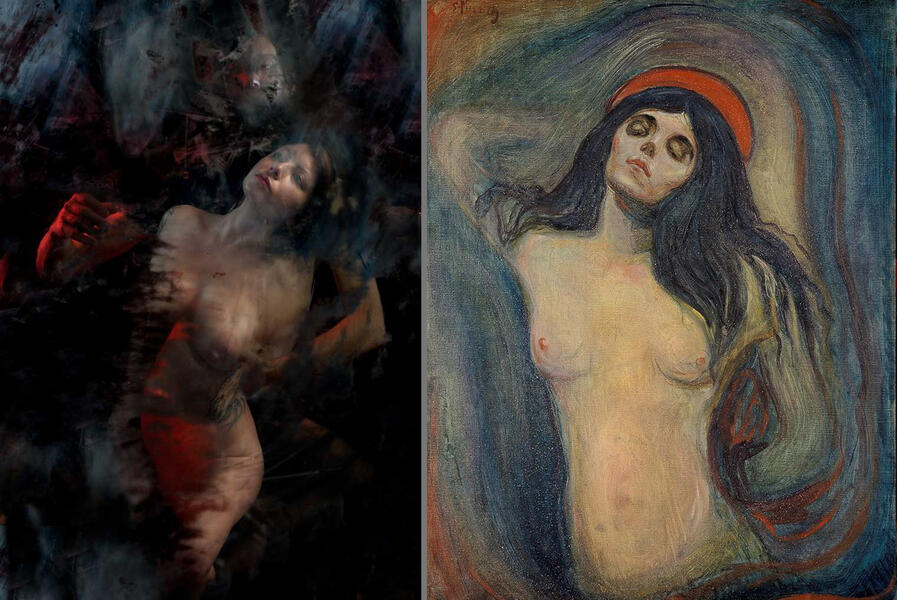 Comparison of Untitled (#9-27-11-0057) with Edvard Munch "Madonna" 1894
Comparison of Untitled (#9-27-11-0057) with Edvard Munch "Madonna" 1894 -
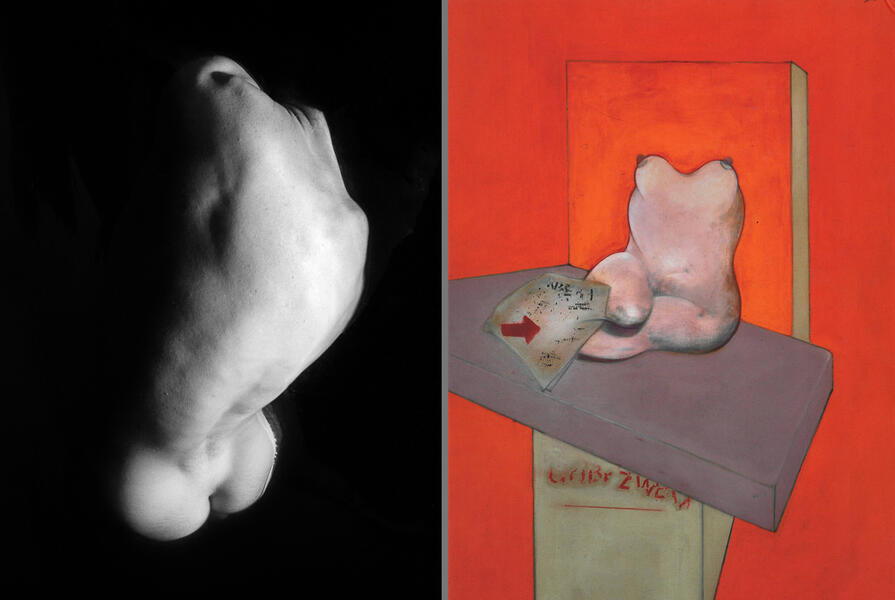 Comparison with Untitled #5893 and Francis Bacon's "Etude Du Corps Humaine D’après Ingres"
Comparison with Untitled #5893 and Francis Bacon's "Etude Du Corps Humaine D’après Ingres"“A new image transforms, but its rightness is rooted in what already exists …”
Jane Hirschfeld, Nine Gates
-
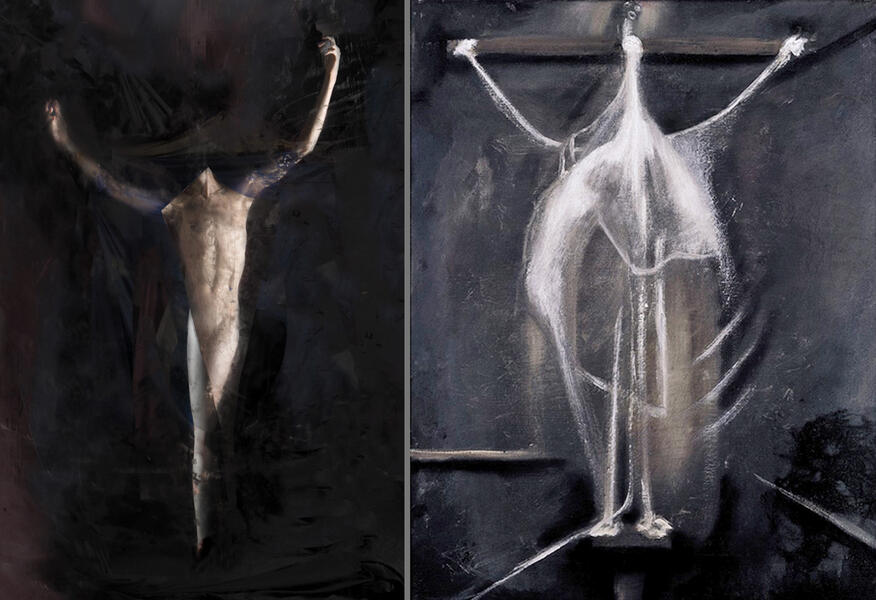 Comparison of Untitled (#06-23-17-534) with Francis Bacon "Crucifixtion" 1933
Comparison of Untitled (#06-23-17-534) with Francis Bacon "Crucifixtion" 1933 -
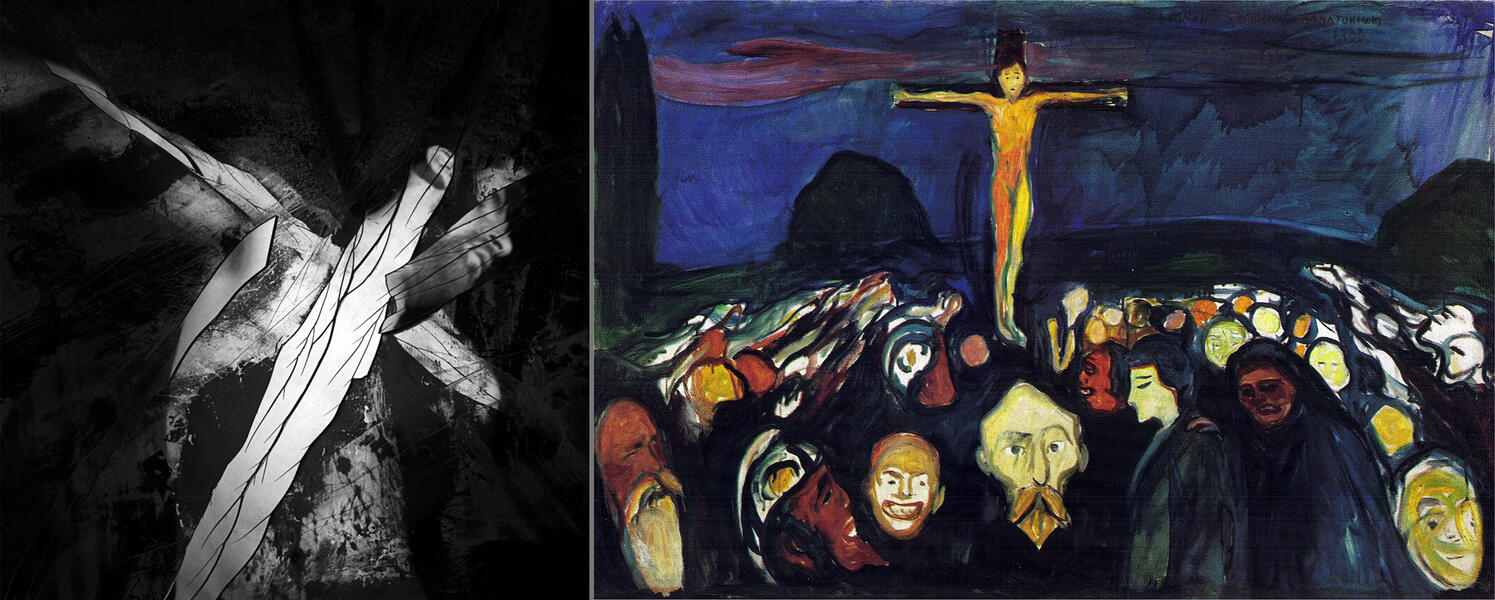 Comparison of Untitled (#9284) 2001 with Edvard Munch "Golgotha" 1900
Comparison of Untitled (#9284) 2001 with Edvard Munch "Golgotha" 1900"The creation of something new is not accomplished by the intellect but by the play instinct acting from inner necessity. The creative mind plays with the objects it loves."-Carl Gustav Jung
Mythological Threads
Art, in its broadest sense, has consistently served as a conduit for exploring universal human truths, and the persistent presence of archetypal patterns reveals our shared psychological experiences.
Throughout history, artists have instinctively tapped into these archetypes, these deeply ingrained patterns, often without the consent of their conscious awareness. From the earliest cave paintings to even abstract expressions of contemporary art, these archetypal themes provide a foundational language for connection. Even when artists like Edvard Munch, in "The Scream," capture the raw, isolating sensation of anxiety and detachment, the art itself serves as a connection between the artist's inner turmoil and the viewer's shared experience of alienation.
Connections such as these are rooted in the archetypal imagery and patterns that thread their way throughout human history. The power of art lies in its ability to tap into these psychological structures, echoing feelings and ideas that resonate on a subconscious level that transcend culture and time. Artists, through their unique perspectives and creative expressions, give form to these universal patterns, translating familiar mythologies in a language relevant for their time. Their art serves as a mirror to reflect the archetypal landscape of the collective unconscious, giving form and understanding to our shared human experience.
-
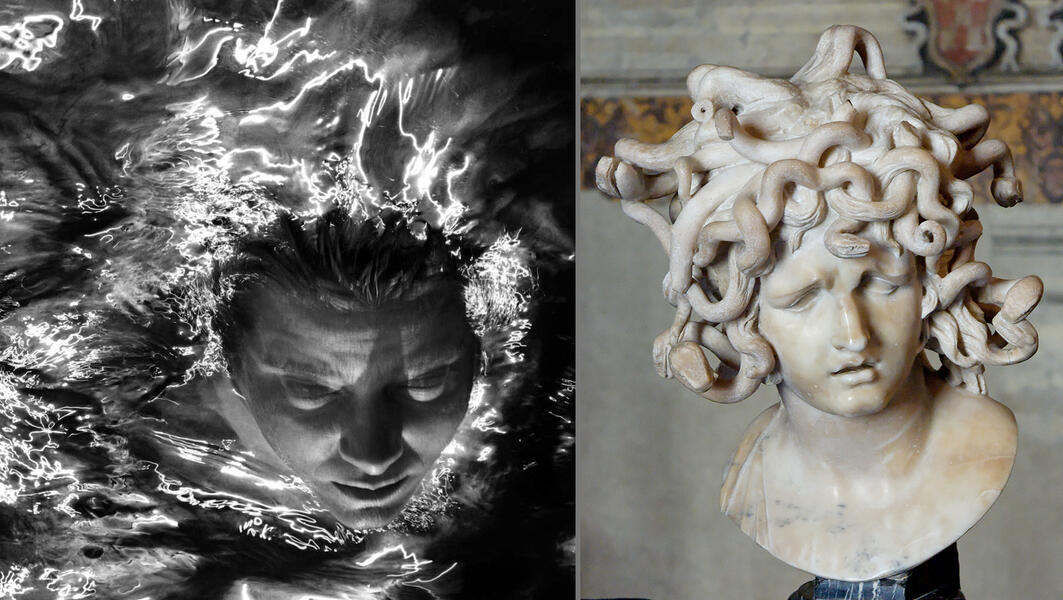 "Fire" 1987 and "Medusa" Sculpture by Gian Lorenzo Bernini
"Fire" 1987 and "Medusa" Sculpture by Gian Lorenzo BerniniMedusa is the myth of a beautiful young women who angered the gods. They turned her hair into snakes so anyone who looked at her was turned to stone.
-
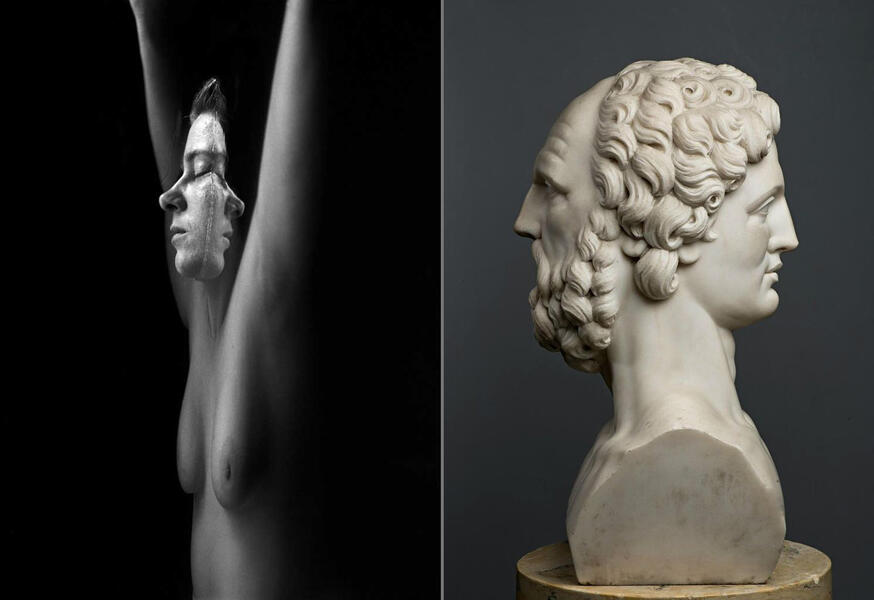 "Dead Silences" 1988 and Janus
"Dead Silences" 1988 and JanusJanus was known for seeing into the future and the past at the same time. He is the god of transitions. The name of the month January comes from this god.
In my second year of grad school I made an image called "Dead Silences". Fellow students in a critique drew attention to the allusion of Janus, an ancient Roman god often depicted with two faces for his propensity to see both future and past, beginnings and endings, etc. Although I pretended otherwise, I of course had no idea who this deity was at the time, and was fascinated by the accuracy, the uncanniness of my colleagues observation.
This early analogy held such an allure for me - that I could unintentionally create something with such a direct resemblance to an ancient depiction - that I had to know more. I discovered the writings of Joseph Campbell, famous author of the Hero's Journey and Hero with A Thousand Faces, who discussed the various archetypes of characters in stories throughout history. My intrigue led me further down this fascinating rabbit hole, and I found myself captivated by the theories of Carl Jung, the Swiss psychiatrist who put forth the theory that archetypes on a much broader scale - not just the characters of story but patterns, symbols, and information that describe our basic humanity - are actually stored within a deep layer of our mind. Similar to instincts, this layer exists beyond both the conscious and unconscious, in a deeper level of the psyche he called the "collective unconscious”….
-
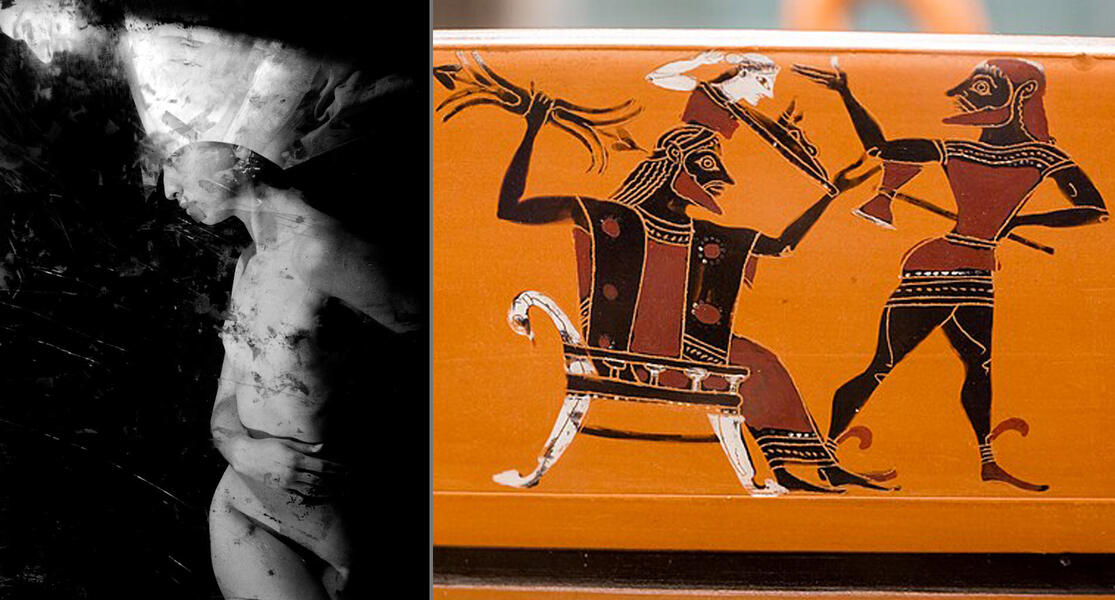 Comparison of Untitled (# 10618) with Birth of Athena_Phrynos Painter Vase Painting
Comparison of Untitled (# 10618) with Birth of Athena_Phrynos Painter Vase PaintingThe greek myth of Athena has her born fully formed, armed and ready for war from the head of Zeus.
-
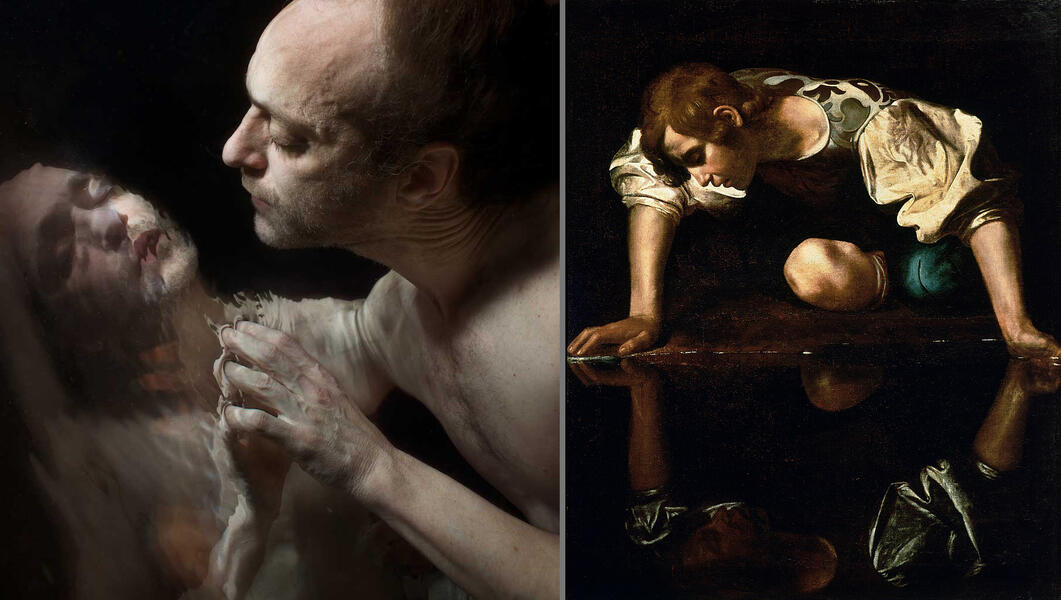 Comparison of Untitled (#04-14-09-462) with Caravaggio "Narcissus" 1594
Comparison of Untitled (#04-14-09-462) with Caravaggio "Narcissus" 1594The myth of Narcissus illustrates a powerful archetype that describes the human condition we call “narcissism”. The most common version of Narcissus comes from the first century BCE, from Book 3 of Ovid’s Metamorphoses, which became a major influence on Western culture. In Ovid’s rendering, Narcissus is an exceedingly beautiful young man who attracts the attention of Echo, a young mountain nymph.
2024 - 2025
In 2024 I found myself working with so much of the same elements from the last few years, bringing those elements together in new ways while at the same time experimenting with different approaches and even some new materials. I quite accidentally (so often the case) discovered a new sense of atmosphere, a depth that was appealing to me, though it is dark, mysterious, and occasionally foreboding.
Unlike my earlier years, I hadn't been exhibiting as frequently- my primary focus has been creating the work- but a successful retrospective exhibition at the end of 2024 caused me to look at the breadth of my work over the last 50 years and see some of the familiar themes and consistent threads that echo across my career as an artist. It also had me consider the various breakthroughs that have emerged throughout all these years, working with the same materials but always making new discoveries. It further encouraged me to take risks, to experiment, and to embrace the uncertainties inherent in the creative process. Throughout 2025, the images I'm discovering feel more than ever like a convergence not only in technical details but in how I'm seeing, in my visual approach and how those things have kept me engaged in photographing the same subject for so many years. I'm still living with some of these images, still trying to understand them, but what I know for sure is that I am incredibly excited to continue this work and for the potential moving forward!
-
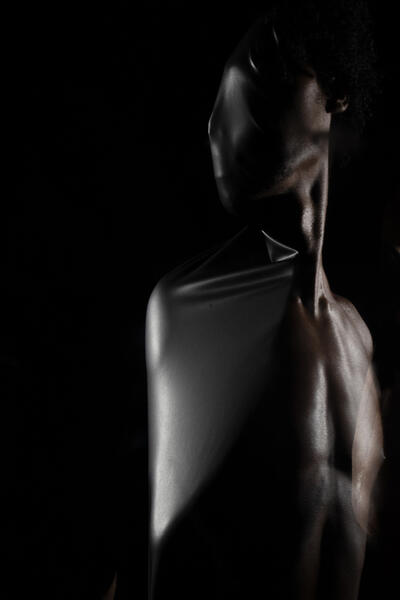 Untitled(#01-26-2024-868)
Untitled(#01-26-2024-868) -
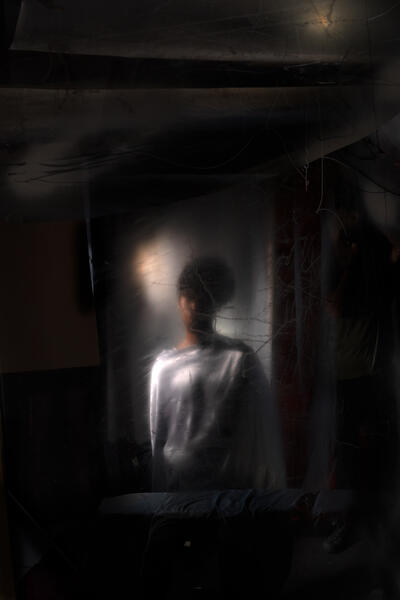 Untitled (#06-21-2024-51)
Untitled (#06-21-2024-51) -
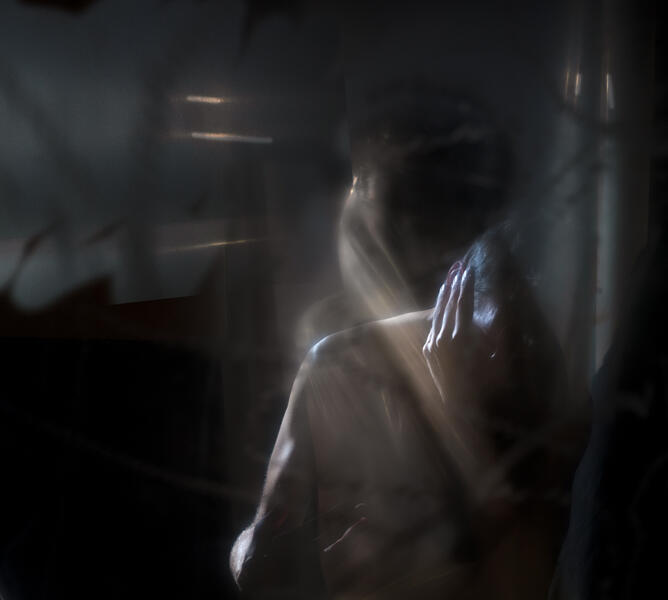 Untitled (#07-19-2024-105)
Untitled (#07-19-2024-105) -
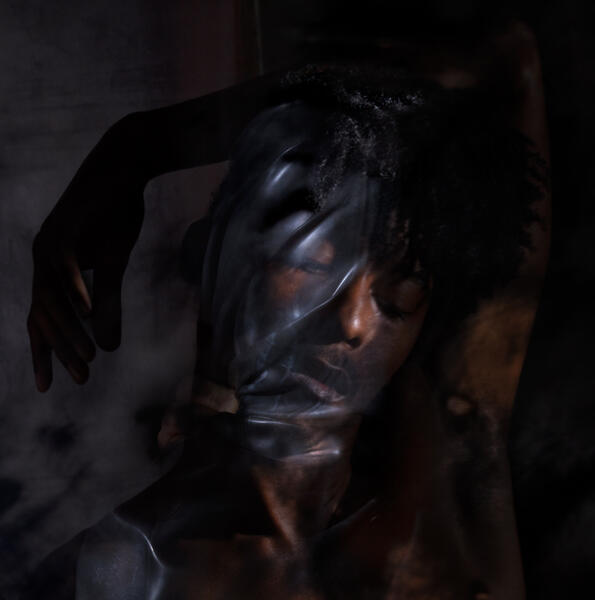 Untitled (#04-30-2025-424)
Untitled (#04-30-2025-424) -
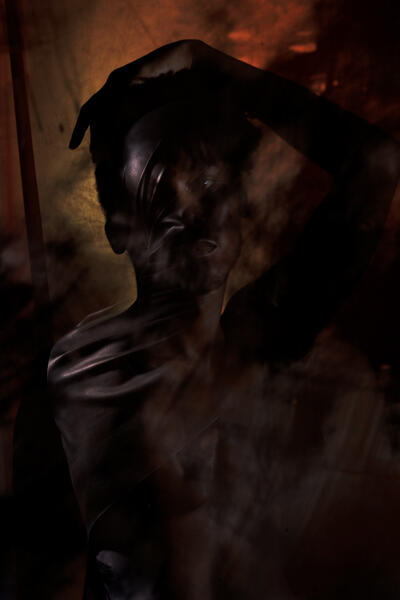 Untitled (#05-13-2025-148)
Untitled (#05-13-2025-148) -
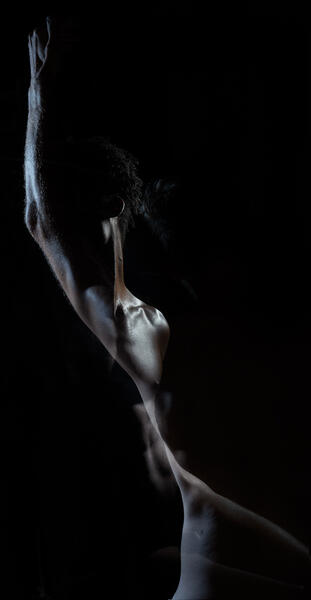 Untitled (#07-18-2025-452)
Untitled (#07-18-2025-452) -
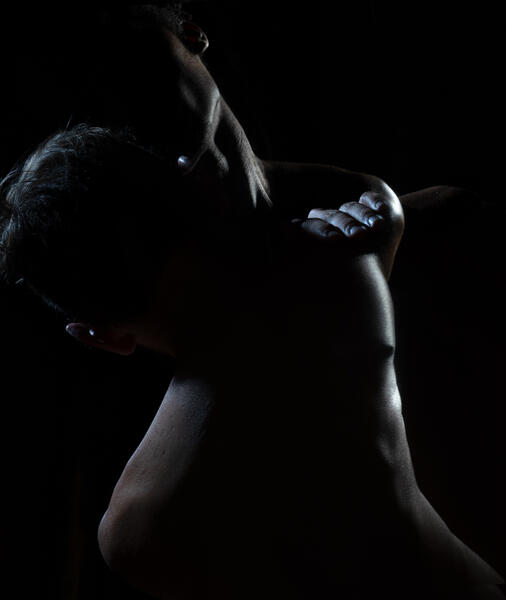 Untitled (#07-18-2025-578)
Untitled (#07-18-2025-578) -
 Untitled (#08-15-2025-72) 2025
Untitled (#08-15-2025-72) 2025One thing I continue to marvel at in some of these more recent images is the fluidity and grace of some of the forms that echoes work from the water. I don't always understand where it is going or what it all means, but I recognize in this work the same sort of ethereal quality that came through in many of the images photographed in, above, and below the water's surface.
-
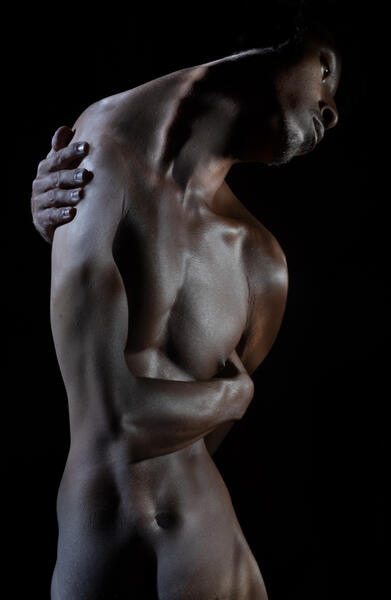 Untitled (#08-29-2025-280)
Untitled (#08-29-2025-280) -
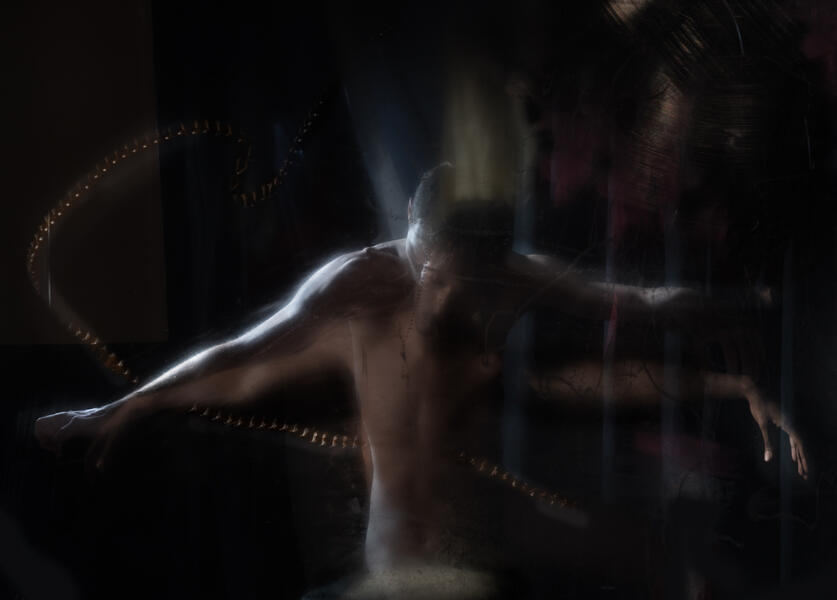 Untitled (#07-19-2024-278)
Untitled (#07-19-2024-278)
2021 - 2023
2021 was as prolific for me as 2020 was sparse. Once the pandemic panic subsided and the COVID vaccines allowed us to start returning to life, I found myself shooting more than ever. I felt like my palette was full of materials and ideas to work with- fresh and and well rested and more eager to create than ever. It was immensely fun getting back to photographing, and I enjoyed being able to simply play in the studio with all of the different materials, colors, and exciting new layers I had been exploring in the last few years- and in my frenzied manic mode of shooting, began putting them together in new ways. By 2022, I found myself merging different bodies in completely different visual ways. I became very interested in the ethereal quality I could achieve in working with the plexiglass, and drifted further from the hard edges of the mirror shards to more delicate, transparent characteristics. Eventually the blending of bodies became seamless as I found more precision within the way figures could come together- how a shoulder could relate to a jaw, or how different lines within the body could echo one another. In some cases, one model's body could become a transparent veil for the other figure. I also discovered how expressive gestures could be elicited in completely unexpected ways, defined by the relationship of how one model's hand, arm, face, or whatever happened to interact with the other.
-
Untitled (#05-21-21-198)
-
Untitled (# 08-13-21-567) 2021
When I photographed this image, I immediately responded to it with the excitement and enthusiasm that comes when I discover unintended connections to other works of art that have had some sort of impact on me. I couldn't quite place my finger on what the figure, form, or gesture seen here reminded me of, and decided to put the question out on social media to see if I could gain some insight as to where I had seen this before. The responses were abundant and absolutely magnificent. I shared some afterwards, such as this comparison to Michelangelo’s hidden self-portrait with Saint Bartholomew in the his masterpiece fresco in the Sistine Chapel.
-
Untitled (# 08-20-21-402)) 2021“The meeting of two personalities is like the contact of two chemical substances: if there is any reaction, both are transformed.” ― Carl Gustav Jung
-
Untitled #01-14-22-451, 2022
-
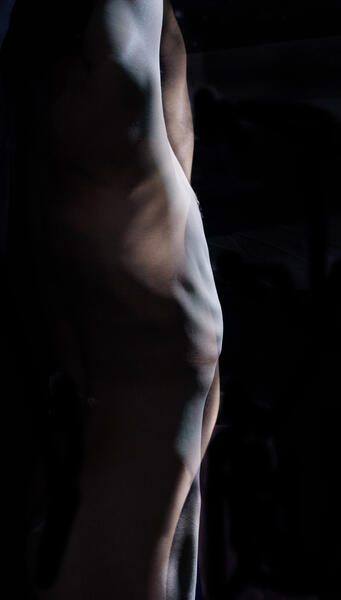 05-13-22-640-Edit.jpg
05-13-22-640-Edit.jpg -
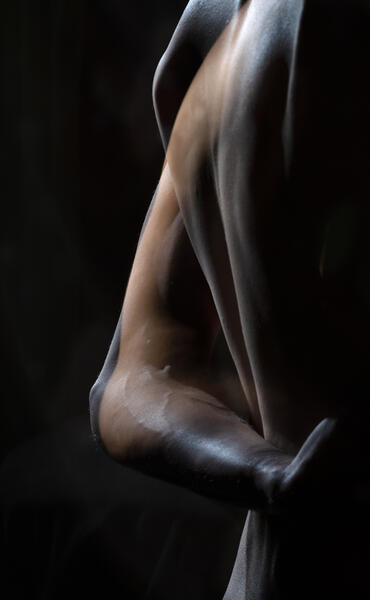 Untitled (#08-22-2023-490)
Untitled (#08-22-2023-490) -
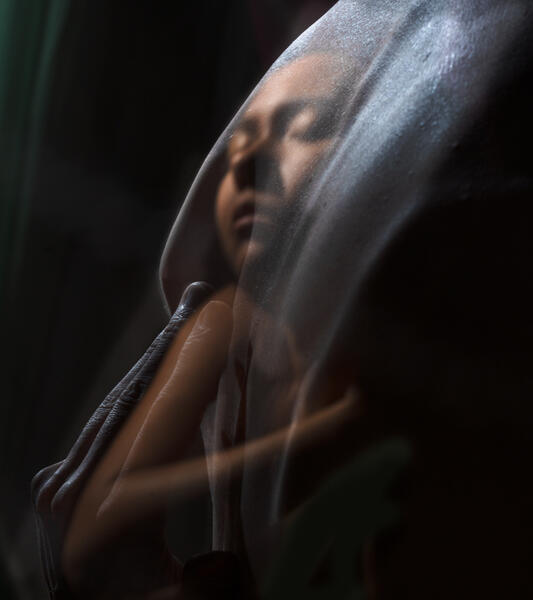 Untitled (#08-18-2023-264)
Untitled (#08-18-2023-264) -
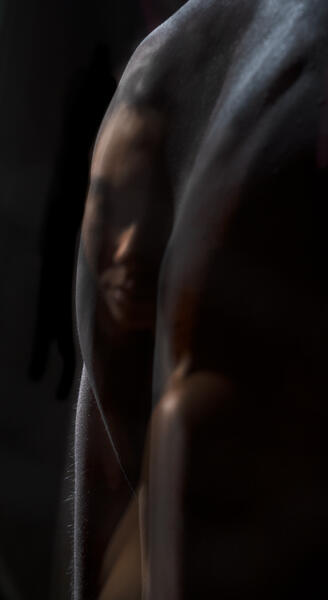 Untitled (#08-18-2023-363)
Untitled (#08-18-2023-363) -
 Untitled (#12-29-2023-225) 2023
Untitled (#12-29-2023-225) 2023 -
 Untitled (#01-17-2023-298) 2023
Untitled (#01-17-2023-298) 2023While it's true for all of my work, every so often an image comes along that reminds me that I could never think of or preconceive these photos. This feels so complex, so intricately illusory, so magnificently bizarre yet makes some sort of visual expressive sense. The way the face fits so perfectly into the shoulder blade, the wrapping embrace of the arms, the evocative expression despite the ambiguity of "what exactly is happening here?". It has taken the entire course of my work - 30+ years - to arrive at the intricate technical aspects that have all had to come together to create something like this, details of which I still am confounded and delighted by. Like an alchemical process, working for years with the same basic materials, transforming the same subject matter into something potent and, to me, something precious.
2017 - 2020
Building the body out of shards of broken mirrors had made me very focused on shape again, seeing form more than the idea of a body. Throughout 2017 - 2018, I found myself fascinated by specific sections of the body, isolated from their function and independent from the rest of the figure. The images remind of the same focus that I had in the hot tub work from 1994-1996, but instead of soft, fluid, and graceful edges, these were sharp, hard edged, and blatantly bizarre and the addition of color gave distinct separation between forms.
2019 was a particularly prolific year for shooting, and I was able to photograph on a very consistent basis. I found myself fueled by fascination for the deep, passionate red that had been prominent in my work throughout the last few years, and came back to focus on it further, determined to explore its powerful presence. The majority of images from this year incorporate this rich, beautiful, and complex color, and I still absolutely love it's effects- at times elegant, other times raw, and always intriguing. Broken shards still built the body up, and I continued incorporating the mannequins, but suddenly they seemed more organic while the human form started to feel more rigid, robotic, or stone-like.
But the productivity of 2019 came to a screeching halt as the COVID pandemic reached new and frightening heights in 2020. Through all the creative blocks and life obligations that have come up throughout the years, I never spent as much time not shooting as in 2020 - the year of the COVID pandemic. Spending the bulk of the year in strict isolation, when I did finally return to photographing, it was only one model. We both masked up, maintained distance by staying on opposite sides of the mirror, and kept the shoots relatively short. Incorporating the ubiquitous face mask was a challenge, but also invited the integration of colored drapes and cloths as a graphic element.
-
Untitled (#09-25-20-38)
"Because Imboden and her models work in such close proximity,the COVID-19 pandemic forced a break in her practice. When she first returned to the studio working solely with her longtime model and studio manager, Cory Donovan, both Imboden and Donovan wore full face shields. These plastic shields became another reflective surface in the dramatic optical play behind Imboden’s images. Many of Imboden’s photographs from this time and the years after are characterized by brilliant flares of color against deep black backgrounds. These arcs and zigzags are created by pulling pieces of fabric with a high sheen across the set of a shoot as an image is taken." - Kristen Hileman, taken from wall text at the Endless Transformations: The Alchemy of Connie Imboden exhibition at The American University Museum in Washington, DC.
-
Untitled (#01-07-19-679) 2019Untitled (#01-07-19-679) 2019
-
Untitled (#07-05-19-401)
2019 was another year where the studio set up and the arrangement of materials - and subsequently, their effect on what I saw through the camera - became incredibly complicated. In retrospect, I look at many of these images and can't even remember how exactly they were created, and I am reminded of one of the reasons I am so drawn to this process and working intuitively. There's no way I could have planned these complex scenarios ahead of time, it would be impossible for me to formulate the way these shapes, lines, and forms exist and interact with one another. Even when I'm shooting, the layers I'm seeing through the camera may seem chaotic or overwhelming, and it is simply a process of trying to visually organize them in a way that makes sense.
-
Untitled (#07-09-19-44) 2019Untitled (#07-09-19-44) 2019
-
Untitled (#07-09-19-685)
-
Untitled (#11-05-18-1079)2018
-
Untitled (#06-23-17-534)
-
Untitled (#11-21-17-412)
-
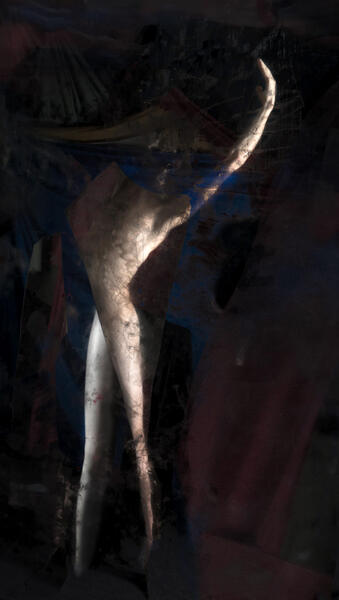 Untitled (# 06-23-17-742) 2017
Untitled (# 06-23-17-742) 2017 -
Untitled (#05-01-17-819)“Heaven and hell are within us, and all the gods are within us." ― Joseph Campbell, The Power of Myth
2008 - 2016
Similar to the struggle I experienced 10 years prior, I found myself facing another creative block towards the end of 2007. This time, in addition to the motivational hurdles that come from a lack of inspiration, the world of photography had gone through changes that were impossible to ignore. Everything was quickly shifting to digital, and even just getting supplies to continue photographing black & white film was a challenge. I once again nearly gave up, and when I invested in my first digital camera, it was with no intention of using it to continue what I considered "My Work", until it led to yet another stunning discovery....COLOR...and more specifically, the transformative effect water has on the interpretation of color. It may sound funny, but after over 20 years of looking at bodies reflected and reformed through water, I never paid much attention to its impact on color. This new discovery for me revealed the significant shift to cooler tones seen underneath the surface, while hues above were much warmer.
It was only a matter of time before my fascination with working in color underwater led to experimenting with the same dynamics in the mirrors. It was not uncommon to be lighting each model with a different intensity of light, but now I wanted to play with varying the color of the light as well, using an assortment of gels and even incorporating colored backdrops and cloths. Eventually I wanted to see how far I could push the color palette boundaries, and soon found myself drawn to a rich, luscious red. To me, it conjured a full spectrum of expressions and was capable of being both attractive or repulsive - often at the same time.
I see the figures in my work from 2012 - 2016 as archetypal embodiments of mythological narrative. They feel like psychological dramas that we either identify with personally or recognize internally. Nearly all of the images throughout these years were created in the studio and working with the mirrors, often times merging the figures together in ways that illustrate a recognizable myth- as in the likeness of Oedipus in Untitled (#09-04-13-287)- or elicit a recognizable state of mind- as in the despair evoked in Untitled (#4-24-12-012). All of the images from this period are quite visceral, and as if tracing further and further back, become more raw, more primitive in essence as I continued this journey. Eventually, the merging of figures became less seamless and more hard edged, moving on to 2016 where the hard edged lines and shapes of the mirror shards become important aspects of piecing them together. The strange amalgamation of these beings got even weirder when I began experimenting with replacing one model with mannequins in various states of completeness - some missing arms, some missing heads, legs, etc. Sometimes, what is seen of the actual figure in an image is quite minimal - as in Untitled (# 06-08-16-429) 2016 - yet the fullness of the body and its gesture remains.
-
Untitled (# 06-08-16-429) 2016
-
Untitled (#01-14-16-502)2016
-
Untitled (#06-06-16-598)
-
Untitled (#09-04-13-287)
Using a red filter on the main light of one model, the skin seems raw, perhaps even stripped of flesh. The eyes appear to be gouged out, and I see this image as the mythic figure of Oedipus, known for blinding himself in the Greek tragedy....
-
Untitled (#4-24-12-012)
-
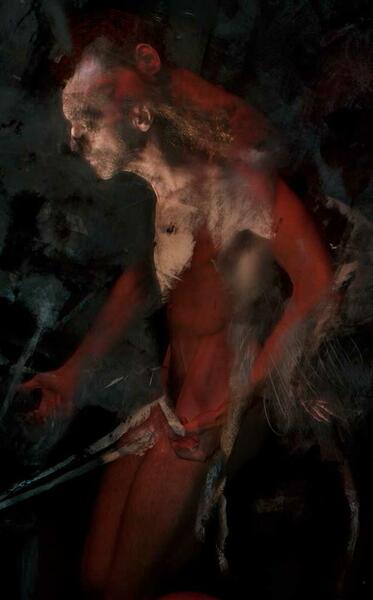 Untitled (# 09-04-13-154) 2013"That's what the gods do - they spin threads of ruin through the fabric of our lives, all to make a song for generations to come." Anthony Doerr from hs book "Cloud Cuckoo Land"
Untitled (# 09-04-13-154) 2013"That's what the gods do - they spin threads of ruin through the fabric of our lives, all to make a song for generations to come." Anthony Doerr from hs book "Cloud Cuckoo Land" -
 Untitled (# 04-14-09-462) 2014
Untitled (# 04-14-09-462) 2014"I weep for Narcissus, but I never noticed that Narcissus was beautiful. I weep because, each time he knelt beside my banks, I could see, in the depths of his eyes, my own beauty reflected.” ― Paulo Coelho, The Alchemist
This image, made in 2009, is just one model and his reflection. The model and I are both underwater, and he is looking up. The figure on the right is aware, conscious and giving all his attention to the figure on the left – his reflection. Though there is in fact only one model, this image shows two entirely different points of view: one as a profile, the other as a full face, resulting in the appearance of two people with distinct emotions. It is no surprise that as I initially studied this image the figure of Narcissus came to mind.
-
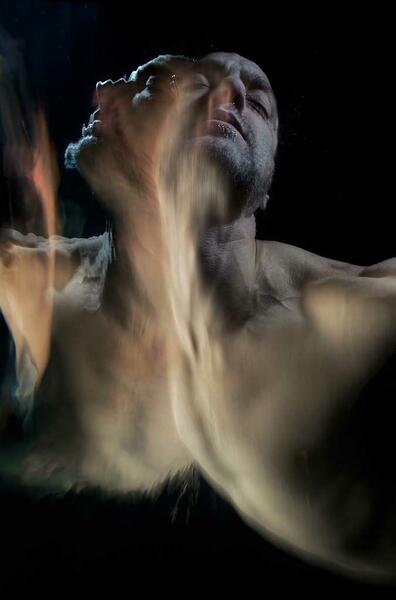 Untitled (# 06-10-09-189) 2010
Untitled (# 06-10-09-189) 2010I love so much about this image, and it became such an excellent illustration of the transformation of color in and out of the water. Photographed from underneath, the model is lit with both an underwater strobe as well as sunlight from above the water. The light from the strobe is not only perceived in cooler tones, but is fast enough to render the model in sharp focus. On the other hand, the light from above the surface is much warmer, illuminating the parts of his body that are both close to the surface and reflected in it. It is a much softer light, made all the more so by movement, and thus has a flame-like appearance.
-
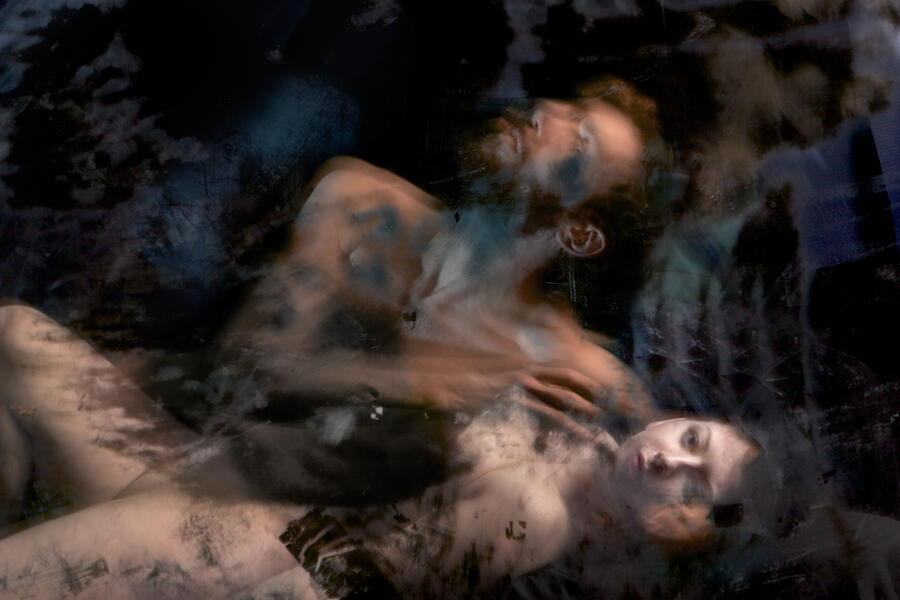 Untitled (#02-09-11-249)
Untitled (#02-09-11-249) -
Untitled (# 9-27-11-005)
1994 - 2007
My journey into the water took me literally into the water, and eventually underneath it. I loved seeing the reflection on the surface from below, and the odd perspective lead to very unusual images, often redefining the forms in such a distinct way that they were nearly believable if not so odd. Between 1994 - 1996, the majority of my work was shot beneath the surface, a time that vastly improved my lung capacity while discovering another visual layer to work with. It was an exciting time, but in 1997 I felt like I had hit the wall. I continued to photograph even though I found nothing that inspired me, and feared the creative well had run dry. But the payoff of continuing to work through it led to a discovery that would keep me engaged for many years to come, and to learn the value of persisting when you feel you're at the end of the rope....(see Untitled #7146 for more)....
From 2001 - 2004, I worked primarily in the studio with the mirrors. The process of piecing together forms and figures had become very exact- the way I could compose to visually line up graphic elements, the shape of mirror shards, the relationship of one form to another all became very important. Most of the figures in the images throughout these years are composite "beings", created from merging two or even more models together into one strange entity. They seem otherworldly, or supernatural, yet because their composition is so precise, they seem almost believable. There is an elegance, a grace to their gestures, which was the basis for where the creative path took me next...
After such intense looking and the arduous task of being so meticulous in visually aligning shapes and forms, my eyes needed a break. In 2005, I returned to photographing in the water, once again simplifying the body to the most minimal, graceful forms I could find. The mirrors had become so complex, with so many intricate layers, that I needed respite in the sheer beauty of the way water can reshape the body. This work resonates with the same lucid, ethereal quality that I had discovered much earlier in images like Untitled (#4442), 1992, only this time, I was determined to streamline the body into an even much slimmer, simpler form. How much of the body could I not reveal, or how little of it could I show, and still have it read as a body?
-
Untitled (# 10914) 2005"The creation of something new is not accomplished by the intellect but by the play instinct acting from inner necessity. The creative mind plays with the objects it loves." -Carl Gustav Jung, Psychological Reflections
-
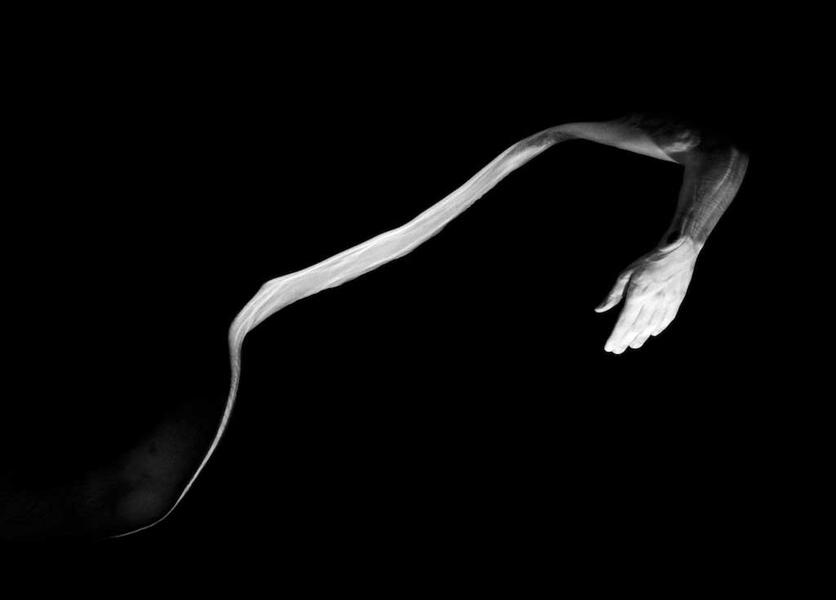 Untitled (# 11159) 2005
Untitled (# 11159) 2005 -
Untitled (# 9535) 2002
-
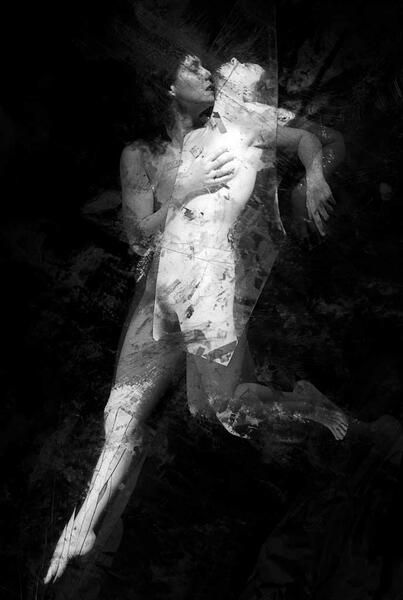 Untitled (# 10412) 2003
Untitled (# 10412) 2003Over the years, I found that every exciting discovery made working in the water leads to thrilling revelations working in the mirrors, and vice-versa. Each body of work informs the other, and when I returned to photographing with mirrors in the early 2000's, it was as if I was equipped with a whole new visual toolkit. The subtlety of camera angle and the precision it took to find the right one in the water was well suited to pursuing the harsh angles and complicated relationships in the mirror's reflections.
-
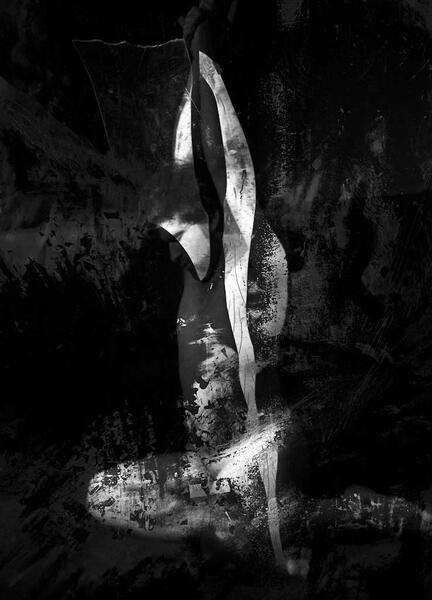 Untitled (# 9607) 2002
Untitled (# 9607) 2002My approach has always been an intuitive one- I never go in to a shoot knowing the type of image I want to create, or with a plan to make something look a certain way. I could never have conceived of these images before seeing them through the lens- they are far too complex for me to have imagined ahead of time. Rather, they come into existence through a process of looking at shape, line, and form seen in various layers, and attempting to compose these elements in a way that simply makes visual sense. Sometimes, it works. Sometimes, I am able to get out of my own way and make room for visual poetry to speak for itself.
-
Untitled (# 10471) 2003
The complexity of working with the mirrors intensified, and before long I found myself working with elaborate arrangements of numerous shards, varying textures, and more than just two models. Body parts were further transformed by pieces of mirror, and many times throughout this stage the human form was transformed into archetypal figures of myth.
-
Untitled (#7146)
I believe every artist experiences "The Dreaded Block" - those times of feeling like you've hit a wall, where inspiration and direction seem to come to a halt. Some last longer than others, and for me, 1997 was one of the longest. This image was the breakthrough that broke the dam and flooded my creative world. The hand's reflection is condensed into the miniscus, and creates the illusion of reaching in to- or out from- the figure. This incredibly minute but hugely impactful detail completely transformed how I had been seeing the figure from under the water, and opened the door to a whole new world to explore
-
Untitled (# 8295) 1999
-
Untitled (#5978,) 1994
This has been one of my favorite images from this era. I love the rawness of it, how primal it feels. I've written extensively on the unintentional connection it bears with the work of one of my artist idols, Francis Bacon.
-
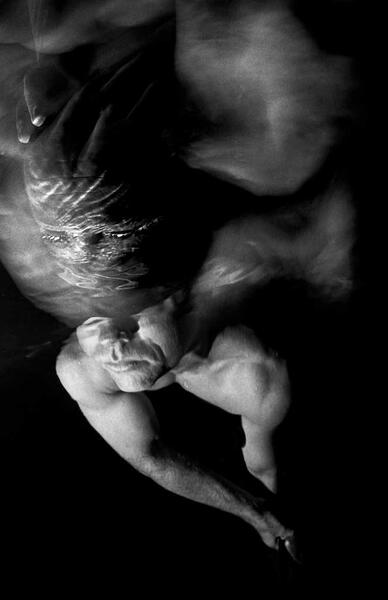 Untitled (# 6576) 1996
Untitled (# 6576) 1996
1986-1993
I have always been a very visual person.
When I discovered working with photography, I loved it's capability to allow me to see graphically- to discover the simple beauty of lines and shapes, independent of whatever the subject may be. No matter how my work has evolved throughout the years, no matter how complex the seeing through visual layers of reflections, no matter how weird, dark, and/or psychological it gets, my primary focus is and has always been to make it work visually, and then trust the poetry or metaphor will follow.
As a young, angsty photography student, I discovered the potential for illusions and distortions in photography to tell a higher truth, to be an expressive art form as opposed to a tool for documentation. These two approaches and my enthusiasm for the medium were, and still are, at the core of my passion, and set the stage for what would kick off a life's worth of work....
In the mid to late 1980's, I found myself drawn to the specular way water reflects light, and the potential it had for creating visually poetic layers. Many of these were photographed in streams and open puddles of water after a heavy rain before bringing myself to invest in a kiddie pool that I lined with black fabric to intensify and isolate the reflection. In those early years, I was limited by the time of year- cold winter months made it impossible to find models willing to submerge themselves in an outdoor, half frozen kiddie pool. Go figure. So I began experimenting indoors, shooting in a studio and working with scratched, broken, and shattered mirrors. Although the mirrors were harder edged and less fluid than photographing in the water, I was excited by the same potential to create new forms and illusions using reflections and visual layers.
-
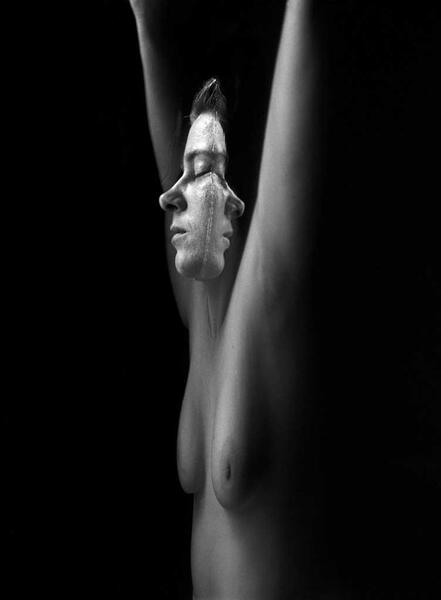 Dead-Silences 1987
Dead-Silences 1987I made this image during my second year of grad school, and during a critique my fellow students drew attention to the allusion of Janus, an ancient Roman god often depicted with two faces for his propensity to see both future and past, beginnings and endings, etc. Although I pretended otherwise, I of course had no idea who this deity was at the time, and was fascinated by the accuracy, the uncanniness of my colleagues observation.
-
Spell 1986
This image is shown flipped vertically from the way it was photographed. I see the figure above as the unconscious, guiding the subject's intuition.
-
Sainthood 1987
-
DEAD SILENCES II 1987
-
Visceral Thoughts 1987(Visceral Thoughts 1987) "Researches have shown that there are all sorts of ways in which the conscious mind is not only influenced by the unconscious but actually guided by it." C.G. Jung
-
Untitled (#1894) 1988
-
Untitled (#4442) 1992
"There is no excellent beauty that hath not some strangeness in the proportion." Francis Bacon
Working in the mirrors was very exciting, but also physically and mentally draining. Many of the images were psychologically heavy, and visually quite difficult to create, and so I returned to the water, this time working with a hot tub and underwater strobes. I found myself drawn to simplifying the human form, finding elegant lines, graceful movement, strange yet beautiful and distinctly human shapes. It also offered an opportunity to do something I tell students all the time- to simplify. The light from under the water would isolate the submerged forms, and the distorting effect would often give the body a fluid, ethereal feeling.
-
Untitled(#3725) 1991
I cannot explain how many of these images came to be so psychologically challenging. I have known darkness intimately throughout my life, and the emotions I felt from these were not alien to me. At that particular time, however, I was not having any crises when these images were made; on the contrary, I was quite pleased with how my career was going and there was no angst in my life at the moment. Neither was it my intention to illustrate an expression of any particular emotion or psychological condition. I felt these images came from someplace outside of myself, and I have since come to recognize that this is the power, and also the danger, of the intuitive process. It does, if followed, eventually lead directly to some deep, core stuff, and that core stuff can be quite dark. I have often been tempted to turn my back and quit; the process has been hideously difficult at times, uncomfortably revealing at others. It has also been the most profoundly satisfying endeavor that has opened up the world to me and brought my life meaning and great joy.
-
Untitled (# 3874) 1992
-
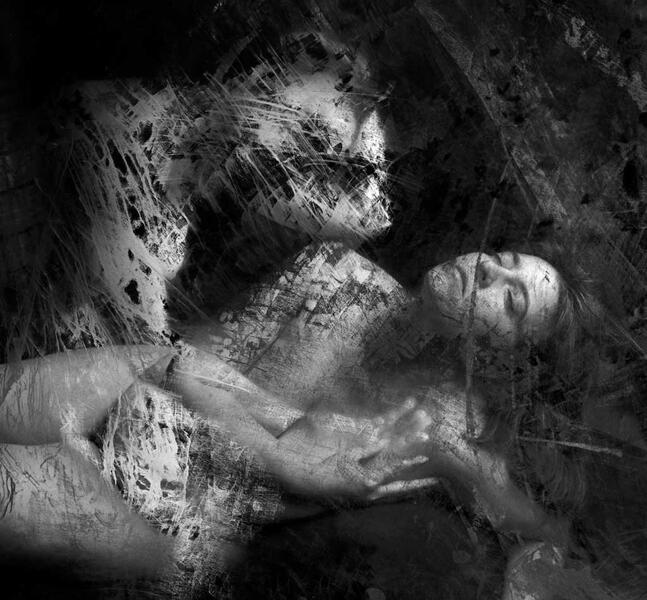 Untitled (#3573) 1990
Untitled (#3573) 1990My fascination with reflections discovered in the water grew, but in those early years was limited by the time of year- cold winter months made it impossible to find models willing to submerge themselves in an outdoor, half frozen kiddie pool. Go figure. So I began experimenting indoors, shooting in a studio and working with scratched, broken, and shattered mirrors. I soon found that by working with models both in front of and behind large mirrors with much of the backing removed allowed me to light each figure differently and create unusual interactions and captivating relationships between them.





